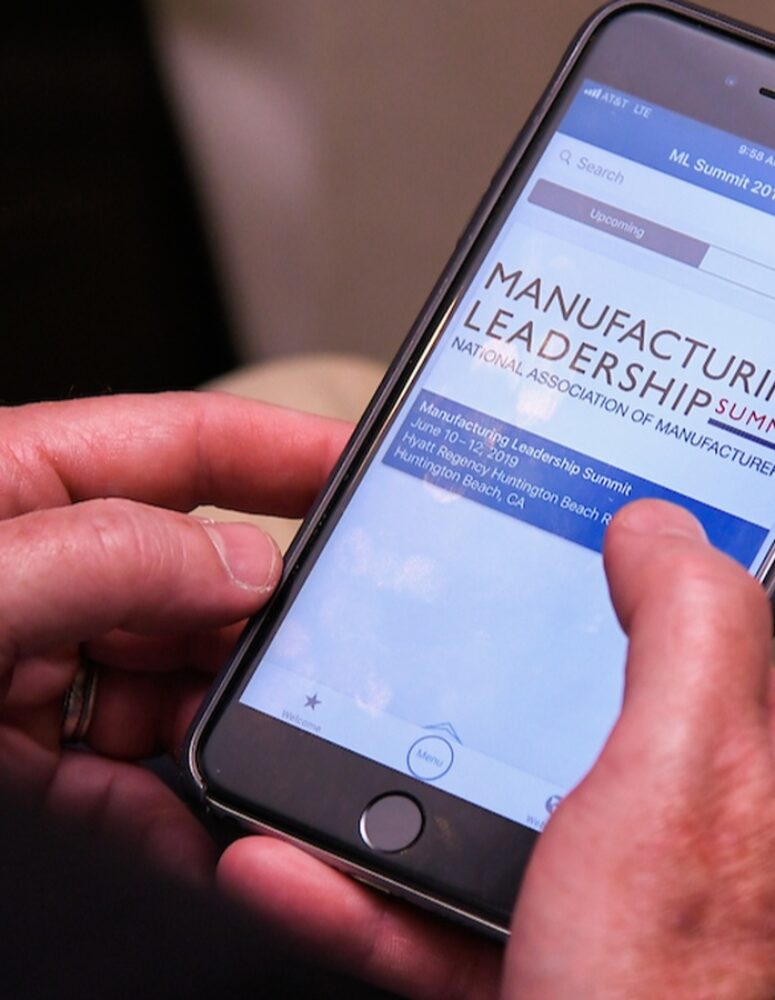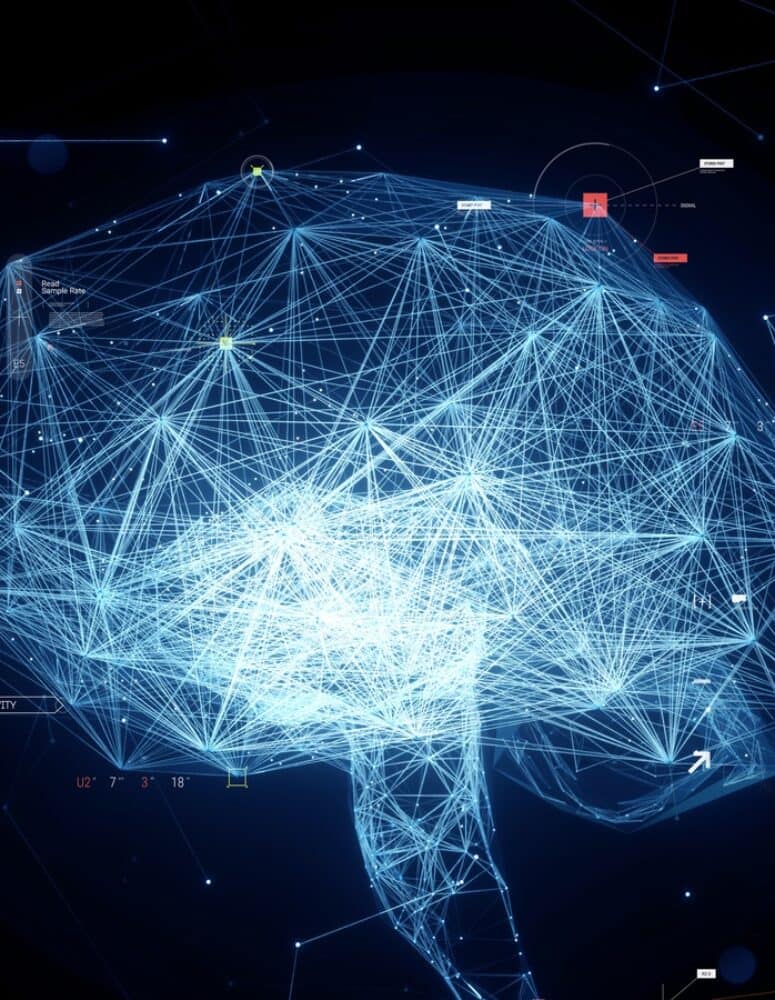SURVEY: Choppy Supply Chain Seas Making Skilled Sailors
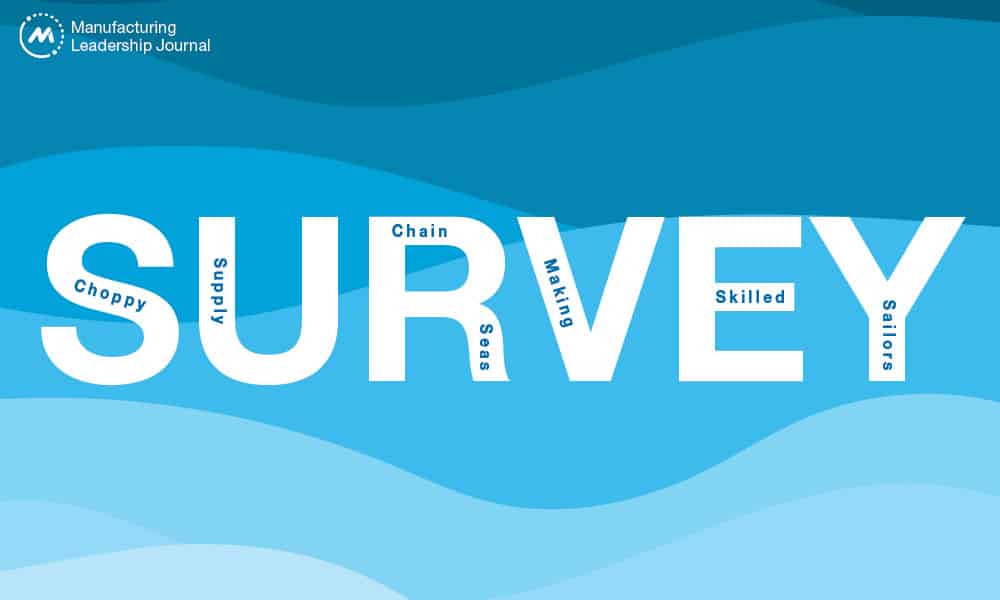
MLC’s latest survey reveals continued disruptions and challenges but big shifts in digital technology deployments and supply network geography.

Franklin D. Roosevelt is credited with saying, “A smooth sea never made a skilled sailor.”
As we move another year away from the COVID-19 pandemic that set off a wave of supply chain disruptions, we continue to see how those initial ripples have been amplified and compounded by component and material shortages, inflation and transportation cost increases, worker shortages, military conflict, political tensions, and other complexities that have tested supply chain resiliency.
In the face of these stormy seas, the manufacturing world continues to implement technologies and solutions to help overcome ongoing disruptions while girding supply chains for a more resilient future.
The MLC’s latest Resilient M4.0 Supply Chain survey reveals manufacturing leaders’ expectations and insights related to supply chain challenges, digital technologies, partnerships, and resiliency. It is clear that disruption still abounds, and respondents expect this to continue for at least the next 12-24 months.
At the same time, this year’s survey indicates that supply chains may be less resilient than our 2022 survey found. Nearly 23% of respondents now say their supply chain is not resilient – up from 12% last year. Perhaps, this sentiment is driven by the necessary rapid digital transformation and geographic shift that many supply networks have undergone.
If the supply chain waters remain choppy, manufacturers’ efforts to implement technology, transform their supply networks, and create better partner collaboration will lead to skilled sailors who can navigate future disruptions or calm seas – whenever those arrive.
Part 1: Supply Chain Disruptions
What started with a single cause for disruption is now a mixing bowl of many disruptive factors that continue to cause issues for manufacturers. Supply chain disruptions that were initially rooted in the COVID-19 pandemic have expanded to include the Ukrainian War, tensions with China, and more.
Still, survey respondents report that pandemic-induced disruptions have eased some. About half say they have eased significantly or partially while 47% say they have only eased minimally. [CHART 1] Meanwhile, other high-visibility supply chain disruptions from the Ukraine War and China tensions are not causing significant disruptions at this time, with nearly 67% of respondents reporting minimal or no disruptions from these catalysts. [CHART 2]
Despite the easing of disruptions from the pandemic and the reported low impact from Ukraine and China, respondents still see supply chain disruptions lingering for some time. In fact, nearly 36% believe disruptions will last for more than a year and nearly a quarter more believe the disruptions could stretch into 2025. [CHART 3]
Perhaps the lingering supply chain issues stem from several disruptive forces and a synergistic effect as several supply disruptions combine to become causes for further disruption. We asked about eight different types of disruptions that manufacturers have experienced in recent years and their impact. Leading the charge, component shortages and excessive cost rises for materials and shipping both ranked as a four or five (highest level of impact) for 17% of respondents, while demand drops, raw materials shortages and reduced productivity from labor shortages and equipment failures round out the top five disruptions with the highest impact. [CHART 4]
But from adversity, innovation arises, and manufactures report they are taking steps to mitigate future supply chain disruption. Among the leading new strategies, 55% say they are adopting supply chain analytics and digital technologies; 48% are increasing their focus on regional or local production and reshoring; 42% are focusing on regional and local supply chain partners; and 39% are improving their supply chain visibility and transparency. [CHART 5]
1. Pandemic-related Disruptions Persist
Q: To what extent have pandemic-induced supply chain disruptions eased for your company? (select one)

2. Global Unrest and Tension Causing Minimal Supply Chain Disruption
Q: To what extent have the Ukraine War and tensions with China affected your supply chain? (select one)

3. Most Expect Disruptions to Subside in Next 12-24 Months
Q: If you are still experiencing supply chain disruptions, when do you expect the disruptions to subside? (select one)

4. Components, Raw Materials, and Costs Causing Biggest Supply Chain Impact
Q: Over the last several years, what have been the most impactful types of supply chain disruptions you have encountered? (scale 1-5, where 5 is highest level of impact)
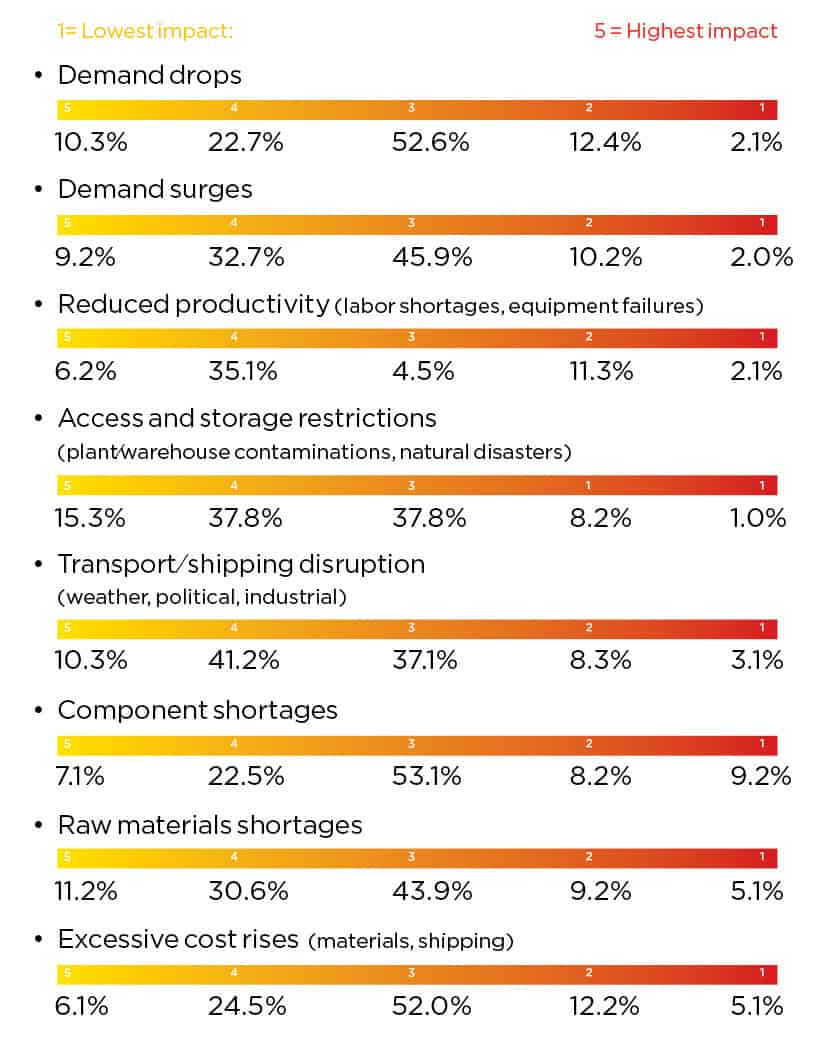
5. Analytics/Digital Tech and Supply Chain Geography are Biggest Strategies to Avoid Disruption
Q: What strategies are you adopting to mitigate future supply chain disruption? (select all that apply)

Part 2: Improving Resiliency
Building off these new strategies, manufacturers report a dramatic shift in their supply chain network’s geography. In MLC’s 2022 supply chain survey, 51% reported a global supply chain network. Now, just 18% of respondents report a global network. This shift has led to a significant increase in those with a national focus (43% in 2023 compared to 12% in 2022) and a combination of different approaches (30% in 2023 compared to 19% in 2022). [CHART 6]
The rapid nature of this shift may be responsible for a less resilient supply chain in the short-term. While most respondents still report their supply chain is somewhat resilient (71% in 2023 compared to 73% in 2022), there has been an increase in those reporting that their supply chain is not resilient. For 2023, that number stands at nearly 23% while it was 12% in April 2022. [CHART 7] Time will tell if this is, in fact, a temporary regression as supply networks realign geographically.
One way manufacturers may be bolstering their resiliency is reexamining traditional supply chain strategies. There is a clear move away from the Just-in-Time (JIT) approach. In 2022, 12% reported that they were continuing to use JIT, while just 3% continue to use it according to the latest survey data. Now, 65% of respondents report that they formerly used JIT, but have moved to a different approach. [CHART 8] Additionally, just under half of respondents (47%) report they are moving towards or have adopted an end-to-end value model other than SCOR. That leaves 2% that are using SCOR and nearly 37% that are adopting or have adopted the SCOR Digital Capabilities Model for Supply Networks. [CHART 9]
As these shifts take place, there is some optimism that the efforts will pay off in the next two years. Forty-one percent of respondents report that their supply chain functions are mostly siloed today, but that number is predicted to drop to just under 12% in 2025. At the same time, partially integrated supply chains are predicted to grow from 49% to 67% while those with a fully integrated supply chain are forecasted to increase from 6% to 18%. [CHART 10]
6. Companies Shift Away from Global Supply Chain Network
Q: Geographically, how is your supply chain network structured? (select one)

7. Still, resilient supply chains remain an issue
Q: How would you rate your current supply chain’s resiliency? (select one)

8. Just-in-Time’s Usage Continues to Fade
Q: How would you describe your company’s use of the Just-in-Time approach? (select one)

9. End-to-End Value Models Moving Toward Majority Adoption
Q: Does your company use SCOR as its basic supply chain model or are you using or moving toward a different end-to-end value model? (select one)
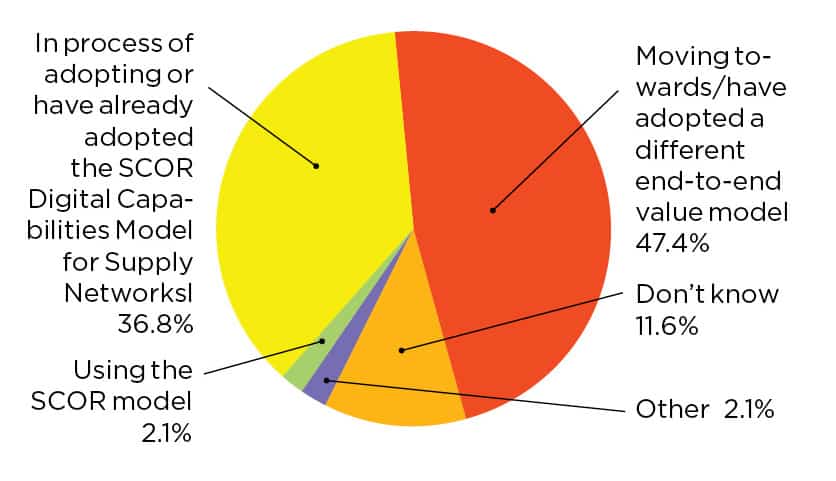
10. Siloed Supply Chain Functions Begin to Disappear
Q: To what extent are your supply chain functions integrated today and do you expect them to be integrated in two years’ time? (select one)

Part 3: Digital Supply Chains
For respondents, their digital maturity for external supply chain functions is slightly outpacing their internal supply chain functions’ digital maturity. Just under 90% say some, most or all their external functions are digitized, while 81% say some, most or all their internal functions are digitized. This means that about 18% of respondents characterize their internal supply chain functions as mostly in an analog or manual state, while about 11% of respondents say the same about their external functions. [CHART 11]
Many technologies are now in use to help digitize manufacturers’ supply chains. Currently leading the pack are cloud systems (in use for 42% of respondents) and augmented and virtual reality (32%). Rounding out the current top five, are artificial intelligence/machine learning, collaborative robotics, and Industrial Internet of Things (IIoT), all of which are being used to digitize just under 31% of respondents’ supply chains. Looking ahead to 2025, use of these technologies will most likely increase. Cloud systems are expected to be in use for 48% of respondents; IIoT is expected to be employed by 39% of respondents; cobot deployments will grow slightly and be in use in 33% of respondents’ supply chains; and AI/ML is expected to be in use for 38% of respondents. Our respondents also expect automated guided vehicle usage to grow from 30% now to 38% in 2025, while augmented and virtual reality usage will slip to 28% in two years’ time. [CHART 12]
As digital technology adoption grows, companies are no longer taking the opportunity to also redesign their supply chain processes. This may be because so many reported that they were redesigning their processes in the 2022 survey. At that time, 72% said they were redesigning their processes as they adopted more digital technologies. In the most recent survey, however, that number has dropped to just 26%. [CHART 13] If AI adoption grows as expected by 2025, it will be interesting to keep an eye on supply chain process redesigns to see if there is a corresponding increase.
11. Digital Maturation Continues
Q: Which description best characterizes the digital maturity of your internal and external supply chain functions today (plan, source, make, deliver)? (select one)

12. Cloud Systems, AI/ML and AGVs are the Present and Future of Digital Supply Chains
Q: What technologies are you currently using and do you expect to be using in two years to digitize your supply chain? (select all that apply)

13. Digital Adoption Not Driving Supply Chain Redesigns
Q: As you adopt more digital technologies across your supply chain, are you also taking the opportunity to redesign your supply chain processes? (select one)

Part 4: Supply Chain Partners
Perhaps driven by more localized supply networks, companies are making an effort to help their supply partners accelerate their digitization efforts. In 2023, 54% of respondents say they are helping their supply partners. This is up significantly from 2022 when just 19% reported they were supporting this effort. [CHART 14] Eventually, these efforts may ensure a more effective end-to-end digital supply network including multiple supplier tiers.
A potential area for growth with partner collaboration is data sharing. Just under 11% of respondents say they share data extensively with some partners while 5% say data is not routinely shared. But there is a light at the end of the tunnel: 38% say they are beginning to share supply chain data among partners and another 46% say they are partially sharing data across their networks already. [CHART 15]
14. More than Half Aid Supply Chain Partners’ Digital Maturity
Q: Has your company made any specific efforts to help support your supply chain partners accelerate the maturity of their digitization efforts to ensure a more effective end-to-end digital supply network? (select one)

15. Nearly All Respondents Share Some Data Between Supply Chain Partners
Q: To what extent is data routinely shared between any or all of your supply chain partners? (select one)

Part 5: Challenges, Goals and Outcomes
To implement an end-to-end digital supply chain strategy, significant challenges exist that must be addressed with organizational and people changes or new technologies. Respondents were asked to identify their top three challenges. Lack of common data platforms across the supply network led the way in the 2023 survey with 48% of respondents identifying this challenge. This is down slightly from 2022 when it appeared in 53% of respondents’ top three. Trailing just behind, 47% of respondents labeled the unwillingness of partners to share data as one of their biggest challenges. Beyond data hurdles, 42% say a lack of leadership buy-in and 36% say low digital maturity of supply chain partners are holding back their digital supply chain strategy. Meanwhile, 32% say that access to an adequate budget or investment is one of their top three challenges. [CHART 16]
Survey respondents are seeking several business goals related to their digital supply chain transformation. Increased supply chain resiliency, improved customer experience, and new business model/competitive advantage rank as the top three most important goals. These were identified as high importance on 43%, 33%, and 31% of the surveys, respectively. [CHART 17]
16. Data Issues Pose Biggest Challenge to End-to-End Digital Supply Chain Strategy
Q: What are your company’s primary challenges in implementing an end-to-end digital supply chain strategy? (select top three)

17. Customer Experience, Resilience Biggest Goals of Digital Supply Chain Transformation
Q: How important are the following business goals associated with your digital supply chain transformation? (rate as low, moderate or high importance)

About the author:

Jeff Puma is Content Director for the Manufacturing Leadership Council
Survey development was led by the MLC editorial team with input from the MLC’s Board of Governors.
Welcome New Members of the MLC August 2023
Introducing the latest new members to the Manufacturing Leadership Council


Mike Bommarito
Executive Director, Manufacturing Services
American Axle & Manufacturing

aam.com
![]()
https://www.linkedin.com/in/mike-bommarito-36b7277/

Paul Burke
SVP Global Operations
Teknor Apex Company

teknorapex.com
![]()
https://www.linkedin.com/in/paul-burke-71548116/
Erik Daron
President – USA
Teikoku Pumps USA
teikokupumps.com
![]()
https://www.linkedin.com/in/erik-daron-2561511/

Bruce Duncan
IT Director
McWane Ductile

mcwaneductile.com
![]()
https://www.linkedin.com/in/bruce-duncan-967a697/

Kim Goodwin
Senior Director, Global Business Development – P&G Product Supply
PROCTER & GAMBLE

pg.com
![]()
https://www.linkedin.com/in/kim-goodwin-0ab1033/

Mario Guerendo
Chief Information Officer
Cummins

cummins.com
![]()
https://www.linkedin.com/in/mario-guerendo/

Coston Wheeler
Project Analyst/Manager
TARA Manufacturing
tarapools.com
Supply Chain Evolution: From Disruption to Resiliency
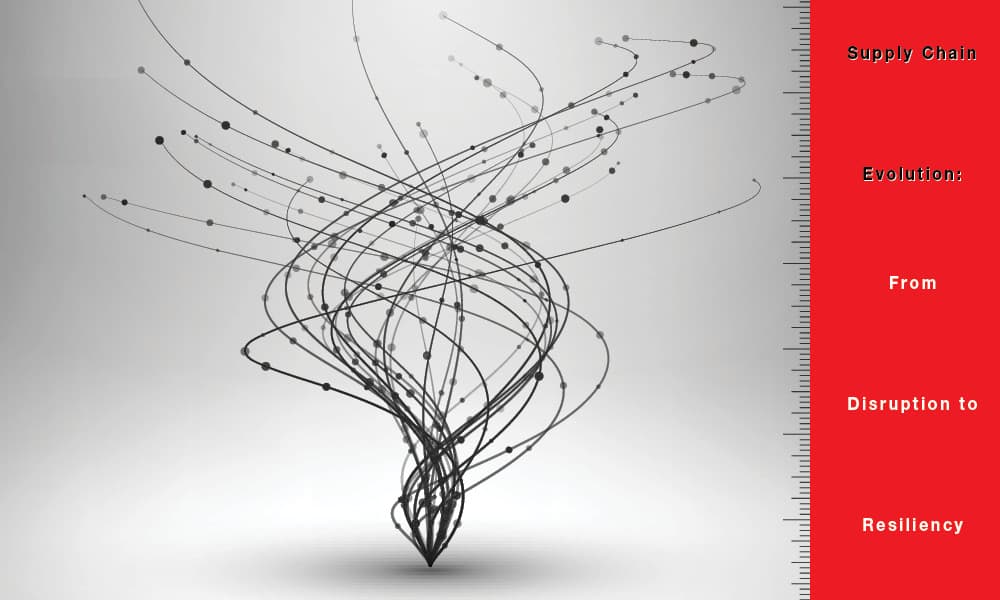
The need to integrate manufacturing and engineering into supply chain planning and the five evolution levels companies need to consider.

TAKEAWAYS:
● True supply chain innovation and transformation come from integrating all key stakeholders and requires a platform approach.
● Invest in people and processes to reach new levels of efficiency and leverage technology to help provide the structure and tools to enable them.
● It is a long journey. Define your end-vision and map out the evolution to achieve incremental benefits to help fund the transformation at each stage.
Introduction
Most companies now consider disruption to be a constant rather than an exception in business operations. This drives increasing challenges for companies in today’s ever-changing business environment. To overcome them, companies have a bewildering array of technologies available, but they should also integrate more stakeholders into the planning process to develop holistic and feasible strategies.
Companies will need to adapt and evolve in order to be resilient against future disruptions. However, adapting to this can be challenging, as there are many philosophies, solutions, and processes available to effect change. Initially, companies should understand some of the fundamentals needed to reach supply chain agility, visibility, and resiliency, and then ask what is needed to meet requirements such as stakeholder integration, defined workflows for managing supply chain risks, access to data, key technology capabilities, and a common operational framework.
Figure1: Fundamental building blocks for Supply Chain Resiliency
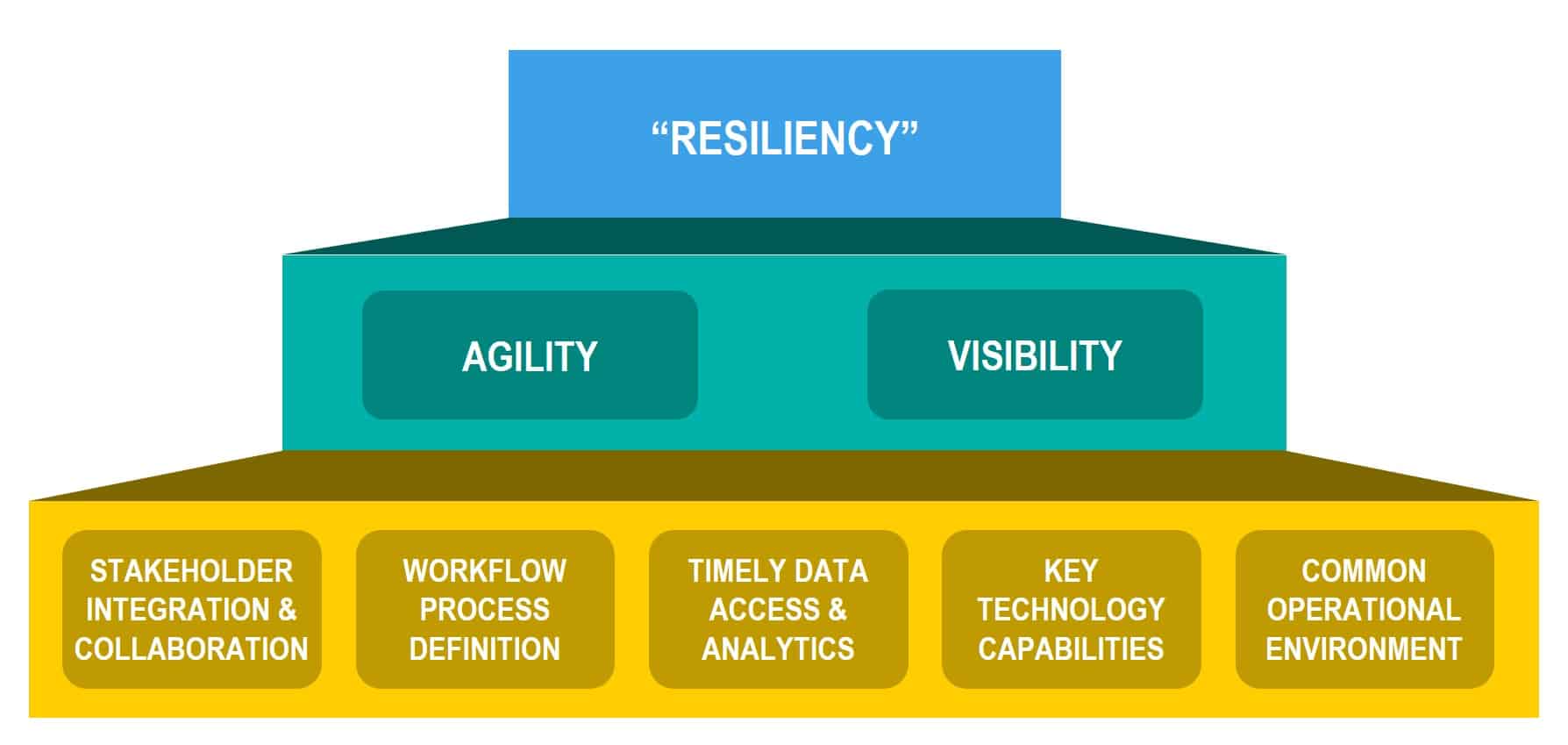
Five Stages of Supply Chain Evolution
Achieving supply chain resiliency is not a short-term endeavor. For most, it will be a journey of progressive evolution, capabilities and results. This evolution can be broken down into key milestone stages that help define important steps and how to focus on process and technology changes.
Figure:2 Key stages of supply chain evolution
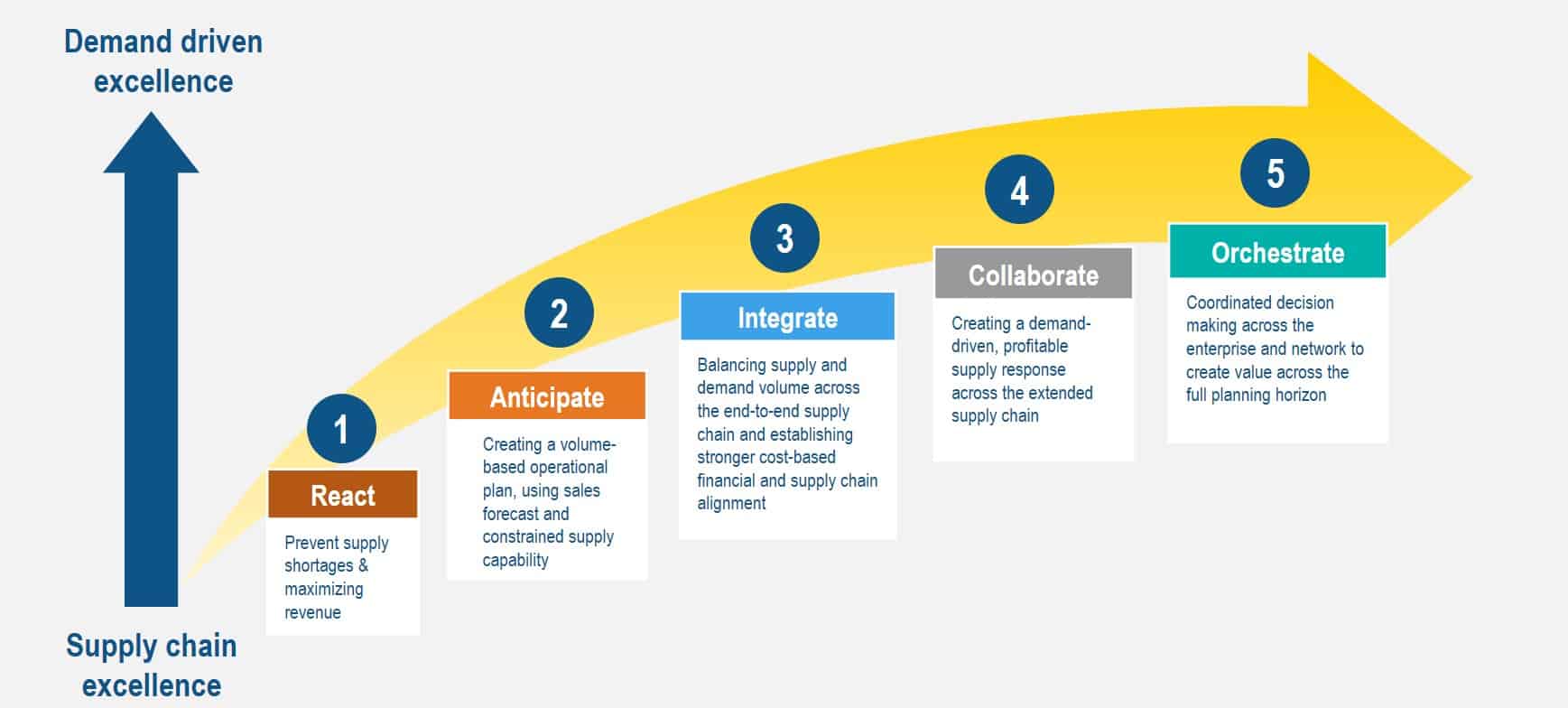
Early Stage Evolution (Stages 1-2)
Companies in the early stages probably still rely on manual processes, spreadsheets, or homegrown applications, and their focus is usually entirely on internal operations. The opportunities at this stage are to enable new levels of automation and more robust processes. This will help stakeholders manage the data and workflows needed to stop reacting and start making more proactive and collaborative decisions. There are also opportunities to introduce the first levels of optimization to help develop better forecasting and planning of operational models.
Mid-Stage Evolution (Stage 3: The Tipping Point)
The fundamental change in focus at the mid-stage is to stop thinking of the supply chain as an isolated and internal operation. Most supply chains are heavily dependent on additional stakeholders inside the organization.
- Operational divisions support the business model, so additional stakeholders need to be included in the decision-making process. Finance is an especially important role to include in the process as they represent the fundamental business metrics and goals for success.
- Supply chain planning is generally strategic in nature, but tactical execution can influence performance and long-term goals. For manufacturers, production operations can both present opportunities in developing strategic plans and disrupt plans already in place. Including manufacturing execution and scheduling as part of the planning process can help achieve strategic goals.
There are many challenges related to collaboration and the management of new types of data and information, but achieving this level of maturity means companies have developed a robust Sales & Operations Planning (S&OP) process and have started to enable the first elements of Integrated Business Planning (IBP).
Late Stage Evolution (Stages 4-5)
Previous stages enabled a maturity level of all internal processes and planning. However, since supply chain operations are often outsourced or dependent on third parties, it is important to consider external stakeholders as part of the collaborative process too. In addition, the growing scope and complexity of the planning process requires new levels of automation beyond just facilitating workflow and data management.
- External stakeholders: Whether it is alternative supply sources, contract manufacturers or logistics partners, it is impossible to make confident supply chain decisions without being able to model the details of the extended value network.
- Autonomous supply chains: It is likely that the workforce managing the supply chain process is becoming busier and/or more constrained. With the explosion of the volume of data and variables now being considered, optimization should now be applied to resolve supply and demand changes automatically wherever possible (e.g., within certain thresholds of acceptable outcomes). This way, supply chain professionals can manage “by exception” and spend their time on value-added activities.
In addition to including external stakeholders, supply chain organizations need to recognize the critical dependencies of other internal divisions on overall success. Some of the greatest opportunities (or risk mitigation) come from considering manufacturing and product design and engineering as critical stakeholders in the planning process.
Integrating Manufacturing & Engineering
Design, engineering and manufacturing processes have a significant impact on overall supply chain efficiency and effectiveness. For example, a design change can lead to better supply chain planning by reducing the number of components or materials, which can lower costs and improve delivery times. Similarly, changes in manufacturing plans can lead to better supply chain planning by increasing production efficiency and reducing inventory levels.

“Companies have a bewildering array of technologies available, but they should also integrate more stakeholders to develop holistic and feasible strategies”
In reverse, supply chain strategies can also affect engineering and production planning. A company may decide to outsource certain manufacturing processes to reduce costs and improve delivery times, which may in turn influence the product design.
Many supply chain problems have root causes in the disconnection between these important stakeholder divisions. Similarly, companies are missing innovation opportunities by not planning holistically across all enterprise stakeholders simultaneously. To achieve true supply chain resiliency, it is now imperative to develop a strategy that integrates manufacturing and engineering into the planning process.
Value Network Orchestration
Adding internal and external stakeholders and data to the process increases the complexity of developing consensus planning. Really, the process becomes more of a need to orchestrate all the numerous elements and possible scenarios to ensure alignment. Two critical technology solutions that can help this orchestration are digital twins and collaborative platforms.
Digital Twins
Already proven for product and facility process modeling, digital twins represent the ideal solution to enable companies to innovate and rapidly experiment with real world challenges without risk or excessive cost. Supply chain planning can benefit from the same philosophy. The supply chain digital twin models the extended value network and uses real-time data to update the status and allow planners to simulate unlimited what-if scenarios to plan for the future.
Additionally, since many companies have already invested in digital twins of their products and resources, connecting the digital twins enables the necessary integration between operations, engineering and manufacturing processes.
Collaborative Platforms
While connected digital twins allow the sharing of data and models, humans are still required to help orchestrate the process. This is where a collaborative platform becomes essential. Just as supply chain evolution moves companies from spreadsheets to automated S&OP, achieving true orchestration means stakeholders should collaborate and communicate as seamlessly as possible.
The collaborative platform provides a common structure for visualizing data, posing questions, publishing scenarios and making confident decisions. As each stakeholder and department may have separate goals and objectives, the key to success is to provide timely information and transparency as they collaborate cohesively on models of the enterprise and plans.
Industry Applications
Every organization has unique factors and challenges but achieving supply chain resilience requires evolution regardless of industry.
Discrete manufacturing industries such as automotive, aerospace, and industrial equipment have already invested in digital twin technologies from design and engineering to process simulation and digital manufacturing. It now becomes a natural extension for their operations teams to leverage the existing digital models during supply chain planning. This makes designing for supply chain a strategic advantage in new product innovation and enables extreme agility and visibility to supply chain challenges throughout the enterprise.

“To achieve true supply chain resiliency, it is now imperative to develop a strategy that integrates manufacturing and engineering into the planning process”
Process manufacturing industries such as consumer packaged goods, energy, and metals are also users of process simulation, but they are also increasingly investing in the digital modeling of their products. Instead of discrete parts, virtual models represent formulations, recipes and ingredient mixes. In the same manner, these industries can inform their supply chain decisions with a more holistic view of product potential and manufacturing dependencies.
Delivering Sustainable Supply Chains
More effective planning helps optimize supply chain and logistic flows to reduce emissions, energy consumption, and waste across the value network. Matching supply and demand with optimized S&OP also means a more efficient use of resources, raw materials and energy.
However, connecting the supply chain to engineering and production operations also provides unparalleled new opportunities to drive sustainability initiatives:
- Digital twin technology allows integration of product design with supply chain planning to design an efficient production system built for scalability and removing excess material waste.
- Efficient product design and engineering as well as considering reverse logistics and disassembly keeps valuable and scarce materials in the supply chain — enabling a circular production system.
- Connecting supply chain planning to downstream operations and consumer feedback allows for innovation in the design of green products, with opportunities to reduce the overall production footprint.
- Connecting a broad range of stakeholders enables more productive continuous improvement collaboration and ideation in areas of efficiency and sustainability.
Value
Each supply chain evolution can bring substantial value and benefits. Simple automation and optimization can greatly increase planner efficiency and accuracy. This efficiency continues to scale as maturity levels increase to include more stakeholders and capabilities, freeing up additional time for key staff to engage in value-added activities.
Efficient planning benefits then become tangible improvements in key company metrics as seen by companies in different industries:
- 10-40% improvement in production throughput
- 15-200% increase in on-time deliveries
- 12.5% savings on operational costs
- 15% reduction in logistics mileage
Additional impact areas include inventory reductions and sourcing costs, but the real value lies in developing a key competitive advantage in the marketplace – to develop the agility to weather disruption and capture new revenue streams at high profit margins.
Summary
Supply chain resiliency is a realistically achievable goal. The evolution that makes this possible is not trivial, but the benefits of gaining this level of agility and visibility is well worth the investment.
Most companies are thinking about the journey that they need to take – what their end-vision needs to look like to make the transformation worthwhile. Some key elements to consider in the thought process are:
- Think broader than just supply chain. True innovation and transformation come from integrating all key stakeholders, especially manufacturing and product engineering.
- Effective integration of stakeholders and technology requires a platform approach. The complexity of working with point solutions or legacy systems prevents efficient collaboration and optimization.
- Becoming resilient is not just about technology. Invest in people and processes to reach new levels of efficiency and leverage technology to help provide the structure and tools to enable them.
- It is a long journey. Get help defining what your end-vision should or could be and map out the evolution to achieve incremental benefits to help fund the transformation at each stage.
The call to action for resilient supply chains is to determine what critical metrics are important to your organization, identify the key stakeholders that influence those metrics (wherever they sit in the organization), and then engage with trusted partners to develop an execution plan. M
About the authors:

Adrian Wood is Directory of Strategy & Marketing at Dassault Systèmes
Johnson & Johnson’s Talloen Named Manufacturing Leader of the Year
Marco Island, Fla. – The National Association of Manufacturers’ Manufacturing Leadership Council has named Bart Talloen, vice president, supply chain strategy, innovation and deployment at Johnson & Johnson as the 2023 Manufacturing Leader of the Year for his role in leading J&J’s digital transformation efforts throughout the company’s operations and supply chain. He is also influential through his involvement in many leading industry groups and through establishing broad external partnerships that have furthered their position as a leading global healthcare innovator.
“Manufacturing is a proven accelerator of innovation and economic prosperity, and the companies and individuals honored at tonight’s award ceremony are world-class leaders in shaping the manufacturing industry of tomorrow,” said David R. Brousell, founder, executive director and vice president at the Manufacturing Leadership Council. “I commend them for their tremendous achievements, for turning possibilities into realities and for their relentless pursuit of excellence in the face of persistent disruption.”
The award ceremony took place at Rethink: The Manufacturing Leadership Council Summit, which examines digital manufacturing as it intersects with technology, organizations and leadership at the JW Marriott Marco Island Beach Resort in Florida June 26–28.
In recognition of the highest scoring projects in each award category, the MLC also announced the following category winners:
AI and Machine Learning
Schneider Electric USA
Collaborative Ecosystems
Dow
Digital Network Connectivity
Celanese
Digital Supply Chains
IBM
Engineering and Production Technology
Johnson Controls
Enterprise Integration Technology
Jabil
Operational Excellence
Corning
Sustainability and the Circular Economy
dsm-firmenich
Transformative Business Cultures
Cisco Systems
Manufacturing in 2030 Award
Anheuser-Busch InBev
AUO Corporation
The Boeing Company
Flex
General Motors
IBM
Pfizer
Digital Transformation Leadership
Melanie Kalmar, Dow
Next-Generation Leadership
Amanda Ahrens, Dow
Lifetime Achievement Award
Dr. Don A. Kinard, Lockheed Martin
MANUFACTURER OF THE YEAR – Small/Medium Enterprise
Starkey
MANUFACTURER OF THE YEAR – Large Enterprise
Flex
The 2024 Manufacturing Leadership Awards season will open to nominations on August 28, 2023. Information about the awards program is available here.
-MLC-
Founded in 2008 and now a division of the National Association of Manufacturers, the Manufacturing Leadership Council’s mission is to help manufacturing companies transition to the digital model of manufacturing by focusing on the technological, organizational and leadership dimensions of change. With more than 2,500 senior-level members from many of the world’s leading manufacturing companies, the MLC focuses on the intersection of advanced digital technologies and the business, identifying growth and improvement opportunities in the operation, organization and leadership of manufacturing enterprises as they pursue their journeys to Manufacturing 4.0.
-NAM-
The National Association of Manufacturers is the largest manufacturing association in the United States, representing small and large manufacturers in every industrial sector and in all 50 states. Manufacturing employs nearly 13 million men and women, contributes $2.90 trillion to the U.S. economy annually and accounts for 55% of private-sector research and development. The NAM is the powerful voice of the manufacturing community and the leading advocate for a policy agenda that helps manufacturers compete in the global economy and create jobs across the United States. For more information about the NAM or to follow us on Twitter and Facebook, please visit www.nam.org.
Survey: On Board with Technology, At Sea with Strategy
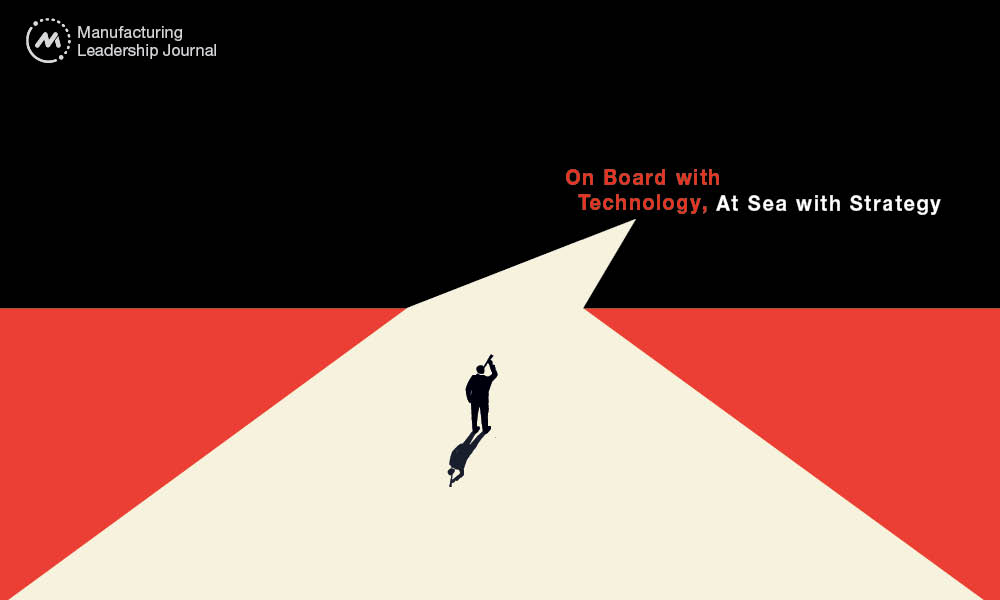
Manufacturing executives want to know what digital transformation can do for their businesses, but an overall plan to find out is lagging for most.

George Westerman, Principal Research Scientist with the MIT Initiative on the Digital Economy, describes digital transformation’s immense opportunity and potential pitfalls with the following analogy: “When digital transformation is done right, it’s like a caterpillar turning into a butterfly, but when done wrong, all you have is a really fast caterpillar.” He contends that business leaders are often thinking only in terms of “fast caterpillars” without focusing on the butterfly that could emerge instead.
The results of the Manufacturing Leadership Council’s Digital Leadership survey seem to indicate that leadership teams are piecemeal in their efforts around digital transformation – they want to know what technology is out there and how it’s used, but for many organizations there is seldom a focus on building or developing a comprehensive digital strategy, there is no change management strategy in place, and no formal training plan to educate workers and leadership on digital transformation.
The takeaway is that many feel their organizations’ future success is vulnerable because of this lack of preparedness – and that an overall lack of strategy may indeed be creating more “fast caterpillars” than digital butterflies.
In terms of overall approaches to leadership, though, most say that there is no significant difference in skills required to be a leader in the digital era vs. prior ones – which could indicate that the tried-and-true qualities of fairness, innovation, assessing competitiveness, and having a clear vision for the future are still what most see as the hallmarks of effective leadership.
Below are more detailed results for the 2023 Digital Leadership survey.
Part 1: M4.0 Organizational Preparation
While the majority of survey respondents said their executive management team is at least partially prepared to lead in the era of digital transformation, a whopping one-third said that team was “not at all prepared” for such change. When this survey was previously conducted in 2022, only 10% said that their executive leadership was in such a precarious position. What may account for this?
Q: How prepared do you think your company’s executive management team is to lead and manage digital transformation? (Select one)

As many job roles of the future do not yet exist, it is understandable that many manufacturers feel they have only a partial understanding of the skills that will be needed in the coming years.
Q: How well prepared do you think your company is in understanding the new digital roles and skills that you will need in the next few years? (Select one)

Change management strategies are still lacking at many organizations – perhaps reflecting an overall lack of understanding on the changes that will be necessary.
Q: Has your leadership team created an organizational change management strategy to help support its digital strategy? (Select one)

Formal training for digital technologies is also nonexistent at many organizations, perhaps unsurprising given the lack of a change management strategy to underpin such transformation.
Q: Does your company have a formal training plan to educate workers and leadership around the requirements of digital transformation?

There is a measured level of anxiety around organizational vulnerability due to digital preparedness level (or lack thereof) – though a slight decrease from the 13% who felt their organization was “very vulnerable” in the 2022 survey.
Q: How vulnerable will your company’s future success be as a direct result of your company’s current level of preparedness for digital transformation? (Select one)

PART 2: The Current State of Digital Transformation Leadership
The most common person in charge of digital transformation typically resides in the C-suite, with the Chief Operations Officer coming in on top with the Chief Executive Officer not far behind..
Q: Who is leading the charge around your digital transformation efforts in your organization? (Select one)

As technology evolves and the associated use cases become more understood, it’s not surprising that executive leadership most frequently wants to know which technologies are best for their operations and how they can be leveraged to their best capabilities.
Q: What’s the most important thing your company’s executive management team wants to know about digital transformation? (Select one)

In addition to the related responses on a lack of change management strategy and lack of formal training for digital transformation, the vast majority of respondents also report that their leadership teams only occasionally or seldom devotes time or attention to developing or updating a digital strategy.
Q: How much time and attention does your leadership team devote to creating and/or updating its digital strategy? (Select one)

Collaboration may be something of a bright spot for digital strategy, as most say that their leadership team is at least somewhat collaborative in this area, with one-fifth saying they are highly collaborative.
Q: How collaborative is your leadership team across multiple areas of the organization in the development and assessment of its digital strategy? (Select one)

It appears that even with an increase in automation and other technologies that can contribute to a reduced headcount, most respondents feel their organization will still have a “help wanted” sign out front. Only 13% see technology having a significant impact on reducing unfilled job openings.
Q: What impact do you think the increasing adoption of automation and advanced digital technologies will have on reducing unfilled job openings in your company in the future? (Select one)

PART 3: A New Era for Manufacturing Leadership
Understanding of technology and its operational integration is cited by far as the best description of what leadership means in the digital era. Using data to make decisions, developing digital ecosystems and acting as a “digital evangelist” for aggressive technology adoption followed closely behind.
Q: Which statements best describe what leadership means in the digital era? (Select top 3)

The more things change, the more they stay the same? Only about a third of respondents felt that digital operations require a significantly different leadership approach vs. any other era.
Q: Do you agree or disagree with this statement: “The emergence of digitally driven operations and business models will require a substantially different approach and set of skills on the part of manufacturing company leadership.” (Select one)

Technological understanding is cited as the most important aspect of a digital leadership approach, followed by instilling a data-driven approach to decision-making throughout the company culture.
Q: Which leadership approaches do you feel are most important in the digital era? (Select top 3

PART 4: What Leaders Need for the Future
The ability to manage virtual and remote teams ranked among one of the more important skills that leaders will need for the future, followed by using data to make decisions and understanding process and functional integration across the organization.
Q: Looking ahead, what degree of importance would you assign to the following digital leadership skills and abilities? (Rate each on scale of Low/Medium/High)
While many respondents said that their organization did not currently have a clear digital strategy for the future, they clearly felt that developing such a roadmap was important for navigating the future, in addition to understanding how the company should be structured and organized to best take advantage of digital technologies.
Q: In thinking about the requirements and implications of digital transformation, what do you think are the most important challenges for leadership? (Select top 3)

About the author:

Penelope Brown is Senior Content Director for the Manufacturing Leadership Council
Survey development was led by the MLC editorial team with input from the MLC’s Board of Governors.
People Powered
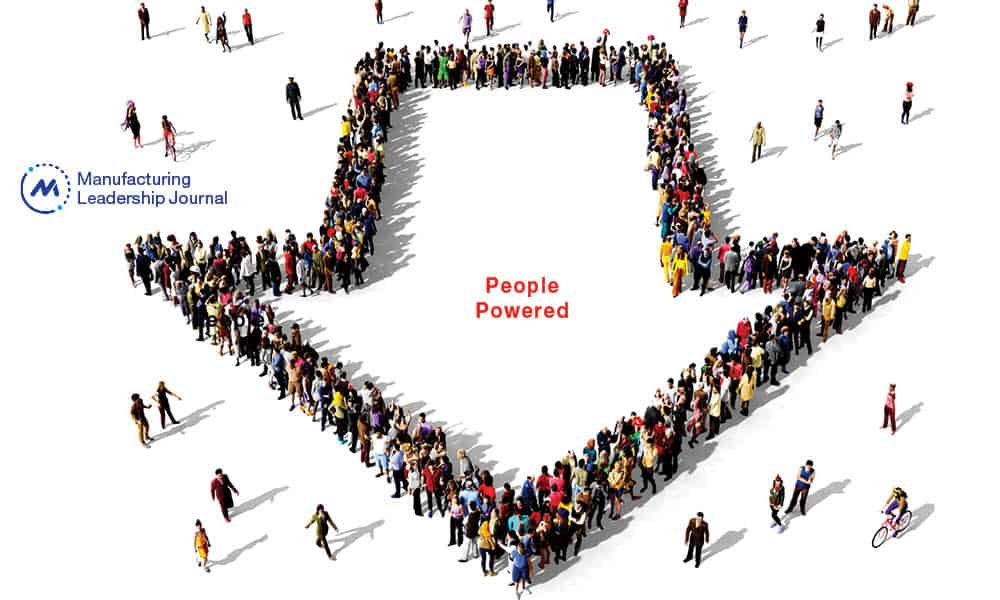
Why putting humans front and center in digital transformation is an essential component to success.

TAKEAWAYS:
● Organizational transformations are vital, yet they often fail because they are approached as a rational business journey and not as an emotional journey undertaken by employees.
● Research shows that manufacturers that focus on and invest in their people are 2.6 times more likely to succeed in their transformation efforts.
● There now is a framework of seven key interconnected and mutually reinforcing elements manufacturers can use to achieve and sustain a succesful transformation journey.
Manufacturers today face many challenges, from changing customer demands to rapidly evolving technology to persistent internal and external competitive disruptions. These are compounded by the exogenous risks of climate change, global health crises, geopolitical tensions, and political market interference.
Because of these ongoing challenges and risks, manufacturers need to transform successfully — and continuously. Their ability to thrive now depends on the agility with which they can quickly change to meet shifting customer, employee, investor, societal, environmental, technological, and regulatory factors.
Yet many manufacturers continue to struggle with such transformation. Why? Ernst & Young LLP (EY US) and the Saïd Business School University of Oxford teamed up on research1 to find out. We studied the complex factors behind the high failure rate of transformations and explored how leaders can drive transformations that result in lasting change.

“Organizational transformations fail because they approach transformation as a rational business journey and lack sufficient attention to the human conditions that drive success.”
We found that organizational transformations fail because they approach transformation as a rational business journey and lack sufficient attention to the human conditions that drive success. Conversely, those that succeed also focus on, and invest in, their people — and their people’s emotional journey — from the beginning. In fact, the research found that organizations that take this approach are 2.6 times more likely to have successful transformations than those that don’t.
Putting Humans at the Center
EY US calls this putting humans at the center of transformation, which involves addressing both the rational (processes, organizational design, and technology) and the emotional (leadership, culture, and capabilities) aspects of the journey in a balanced and integrated way.
Investment in the rational aspect provides discipline, structure, and platforms to manifest the shift quickly, while the emotional investment helps to keep everyone pushing forward, especially when things get messy. Historically, leaders have focused on the rational, logical parts of transformation. These, of course, are critical — they’re the foundation of how the business operates. Yet our research also shows the importance of the emotional journey — fostering positive instead of negative feelings among those involved — to the success or failure of a transformation. Keys to the emotional side include leaders who engage and rally their people around the change, a culture that encourages people to take ownership of the new ways of working, and capability-building to ensure that people are equipped to thrive in the new environment.
Building on these insights, we have converted what were identified as key drivers of successful transformation into a framework that can be used to stress test the likely efficacy of any given transformation program. (Figure 1) This framework consists of seven interconnected and mutually reinforcing elements — centered on a compelling vision, or an optimistic view of the future in which everyone can believe — that address the critical rational and emotional enablers of a successful and sustainable transformation journey.
Figure 1: A framework for putting humans at the center of transformation
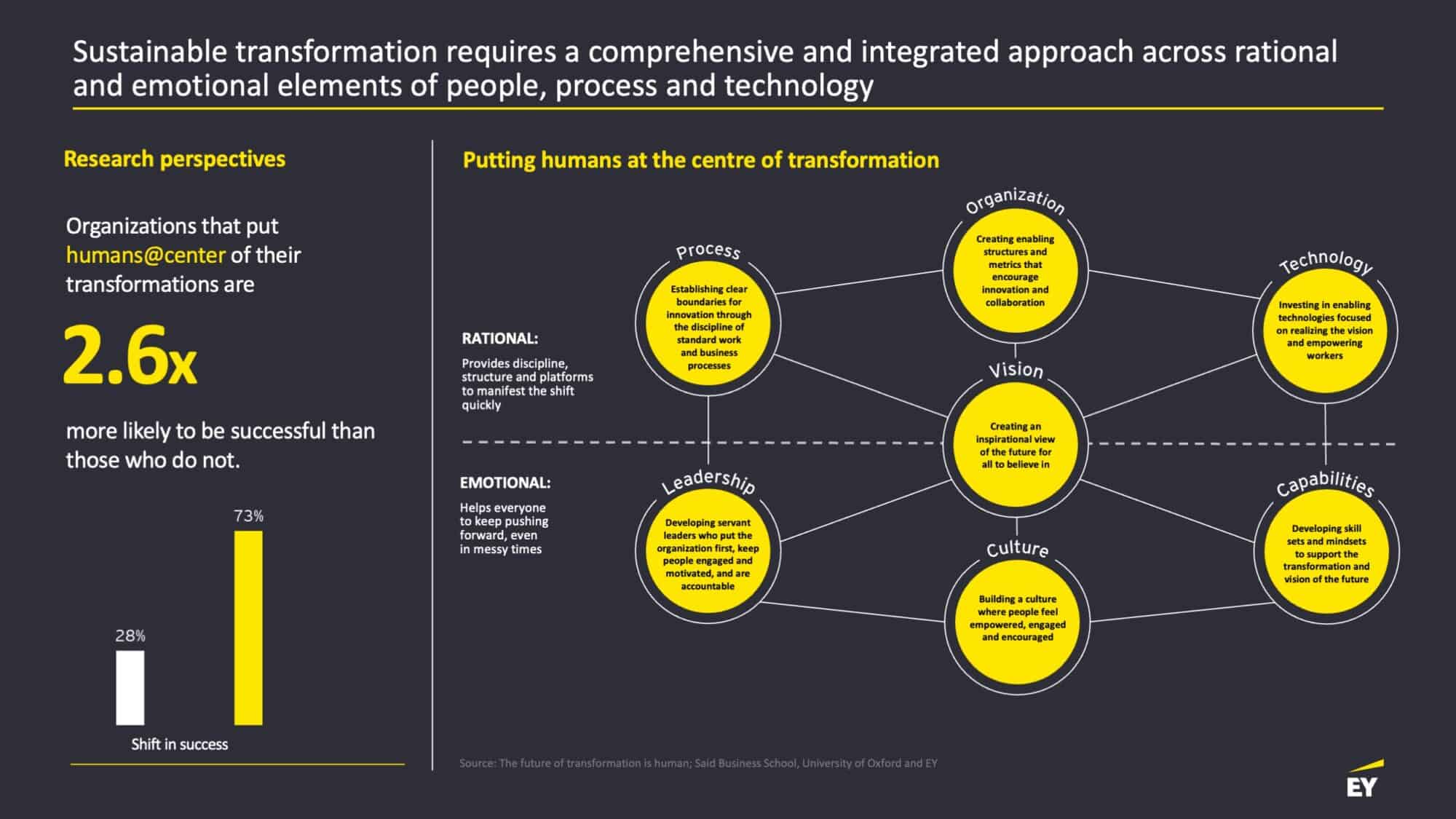
What’s Behind the Failure to Launch?
Based on our research and extensive experience in supporting transformation programs, we believe that companies need to adequately and concurrently address all seven areas of the framework to succeed. Unfortunately, this is where many manufacturers fall short. They may have comprehensive strategies and plans in a few areas, or even most of them. However, they are missing the mark on others, which is compromising their ability to get the most from their efforts.
For example, one automotive manufacturer had highly documented, well-written processes — there was no doubt what people needed to do to execute their jobs. But this wasn’t translating into the results that the company expected. A big reason was that the company lacked a compelling transformation vision that connected with employees. People knew what they were expected to do, but didn’t know why they were supposed to do it.
In another company struggling to make headway in its transformation, leaders, while acting with good intentions, were unknowingly thwarting change efforts. Essentially, they put accountability before capability. They expected workers to inherently understand new processes as well as they did. They weren’t giving workers the time and psychologically safe environment to explore and try out the new ways of working before holding them accountable for performance. They also underestimated the amount of capability-building needed for many of the workers to become proficient and effectively deliver on the shop floor.

“We believe that companies need to adequately and concurrently address all seven areas of the framework to succeed. Unfortunately, this is where many manufacturers fall short.”
A third company wasn’t getting results because it hadn’t identified the new incremental tasks that employees were expected to perform. The company had a massive three-ring binder that spelled out in minute detail its focus on building a future state culture. But leaders hadn’t taken the crucial next step to define what that means for people on the shop floor. Exactly what do workers need to now do differently on a daily basis? Workers weren’t disinterested in participating. They simply didn’t understand how to participate properly.
One of the most common obstacles that companies face is a mismatch between two of the rational elements: process and technology. This was the case at a global multinational manufacturer that was rolling out new software applications. The company felt that it had done all the right work up front to define the use cases and requirements and to pilot them at lighthouse sites, but still struggled with end-user adoption as it deployed the tools at scale. It turned out that the company hadn’t confirmed that the system was consistent with how the organization actually worked, and people weren’t interested in trying something new when they felt their current ways of doing things worked just fine.
A Practical Way to Get Started
As the above examples illustrate, inadequately addressing the human elements of transformation in conjunction with the more rational ones from the beginning most often results in, at best, tepid results and, at worst, outright failure.
How do other manufacturers avoid such outcomes? The obvious answer is that they begin by ensuring that there’s sufficient investment in, and attention to, each of the seven elements of the framework, as outlined in Figure 1. At the same time, it can take significant time and resources to initiate and align these seven elements. We’ve developed a very pragmatic approach that can be adopted at a manufacturing line, site, or network level to help lay a foundation for successful and sustainable transformation. Recognizing a company’s people (particularly those on the production line) will ultimately adopt and drive change, and our approach focuses in on changing day-to-day behaviors in a way that ultimately drives a positive shift in organizational culture.
Practically speaking, this starts with a laser focus on daily tasks. In our experience, the best way to spur behavior change is to first have people learn by doing. This means that leadership identifies a handful of key tasks for people to perform, trains them on the established standard (or current best practice) for each task, and sets them loose to implement the standard (while ensuring that people feel safe enough to make mistakes). The tasks are selected to address key performance improvement opportunities or personal pain points for operating teams, and they may involve leveraging new technology.
People quickly recognize that doing things the right way leads to better performance and a more pleasant job experience — the impact is clearly visible — which inspires confidence in the new way of working and eagerness to embrace it. Importantly, tasks should be explicitly tied to specific targets that teams must hit to help the company achieve its business goals. This helps people understand the direct link between their actions and the success of the business.

“Ultimately, when an organization gets a critical mass of behavior change — say, an entire team on the shop floor — it experiences the dawn of a new culture.”
Soon, with the right support, capability building and context, this new way of working becomes a habit, as people understand that doing things a certain way is just part of their daily job. Now it’s second nature, and the thought of doing things any other way isn’t an option. It’s like when people have progressed in a new exercise regimen and reach a stage where the possibility of not working out or running doesn’t even enter their minds. Here, leadership plays a key role in giving workers intellectual freedom with execution accountability, and in coaching to continue reinforcing the importance of maintaining discipline in how tasks are done so people want to continue doing things the right way even in the face of disruptions that could otherwise distract them.
Eventually, people reach the point at which they intellectually and emotionally know that it’s through the execution of those tasks that they have a better working day. And that’s when they begin to experience an actual behavior change. The timeline for reaching this stage varies by individual. Some people are highly engaged and get there quickly, while others take longer to see things play out. Here again, leadership must remain an active coach — ensuring focus, monitoring ongoing performance with periodic check-ins, demonstrating how people’s actions are addressing the relevant business targets, and encouraging people to actively look for new areas in which they can improve.
Ultimately, when an organization gets a critical mass of behavior change — say, an entire team on the shop floor — it experiences the dawn of a new culture. Everyone is doing their jobs according to the new performance-enhancing standards they’ve defined for their specific tasks (often with the help of new technology), and are updating those standards as necessary as they solve additional problems and learn ways to do things even better. Once established, this new culture and mindset can serve as a crucible of workers’ ideas for solving other problems beyond the shop floor — for instance, a sustainability challenge or any kind of inefficiency — because people now trust the process and the tools, and believe in them because they know that they work. This is when transformation really generates outsized and sustainable returns for the enterprise.
Put Humans at the Center
Today’s manufacturers stand at the precipice of an uncertain world. The nature and impact of disruption are accelerating, intensifying the need for manufacturers to transform. Leaders recognize the critical need for transformation, but many are unsure how to drive it successfully, or, in some cases, they are reluctant to deal with the potential risk involved. Many are still recovering from previous transformation efforts gone awry and are skeptical that a new one will turn out any better.
As our research has found, the key to transformation that delivers significant, sustained performance improvement is putting humans at the center of it all. This means addressing both the rational and emotional aspects of the transformation journey, underpinned by a compelling vision for the future in which people can believe.
A manufacturer’s power is truly in its people. And it’s time for all manufacturers to harness it to build a better business for today and tomorrow. M
About the authors:

Craig Lyjak is a Principal leading EY’s global Manufacturing Transformation solutions. As the leader of the EY/P&G alliance he leads a team focused on innovating methods and tools to create more effective, efficient, and sustainable transformations.

Paul Vail is a Partner in EY Canada’s Business Consulting Practice, Digital Supply Chain and Operations, as well as the Advanced Manufacturing and Mobility Consulting Leader for Canada.
1. As reported in “The Future of Transformation Is Human,” EY and University of Oxford Said Business School, 2022. The research involved a survey of 935 senior leaders and direct reports, as well as 1,127 workforce members from 23 countries and 16 industry sectors. Most respondents had led, or experienced, multiple transformations—both successful and underperforming.
Manufacturers Find Opportunity in AI

How will AI change the work you and your employees do? The Manufacturing Leadership Council—the digital transformation arm of the NAM—is helping manufacturing leaders figure out the opportunities created by new generative AI technologies, including ChatGPT.
Recently, the MLC held a Decision Compass discussion to help manufacturers learn how to take advantage of these new tools safely and effectively.
The participants: The conversation was led by two members of West Monroe’s Center of Excellence for AI: Ryan Elmore and David McGraw. Elmore and McGraw shared their expertise and addressed questions from manufacturers throughout the call.
The use cases: AI is a diverse and complex tool that is likely to have a lasting impact on manufacturers across the United States. According to McGraw and Elmore, there are a range of applications for the technology, from supply chain optimization and production planning to predictive maintenance issues.
The workforce impact: According to Elmore, AI will also transform the manufacturing workforce.
- Some roles that involve repetitive tasks like data processing could be adjusted or eliminated, while some new jobs will be created around tasks like prompt engineering, which ensures AI programs deliver the most useful and accurate results. Most importantly, however, existing jobs will likely be modified to account for new tools.
- “Some are going to go away, some are going to be created, but the vast majority is going to change mentality, change infrastructure, change the way we work,” said Elmore.
Prompting success: Elmore and McGraw emphasized that the key to using generative AI effectively is developing useful prompts. How you ask AI programs for information, and what data you provide, will determine the quality of the output. They provided a few broad guidelines:
- Keep it simple: Your prompts should be detailed, precise and as succinct as possible.
- Data matters: The better and more detailed your data, the better your output will be.
- Keep it human: Generative AI still requires a human to determine the reliability of the output. Manufacturers shouldn’t plan to use outputs blindly without keeping a human in the loop.
- Share safely: Assume anything you put into AI that is not behind a paywall is not private. Only use data that you’re comfortable with others viewing.
- Follow up: If you receive outputs that don’t make sense, or that indicate some sort of failure, ask the program for more context and problem solving to assess whether the output is accurate or beneficial.
Safety first: AI can also be used in negative ways—for example, by cyber attackers attempting to gain private information from you using software that mimics the voice of someone you know.
- Elmore and McGraw emphasized that manufacturers using AI should consider providing trainings so employees can recognize and guard against safety issues.
The last word: “I think most importantly, you’re only limited to your imagination,” said McGraw. “There’s really a lot of use cases that can be solved with this technology.”
Learn more: Want to find out more about how digital tools are changing manufacturing? The MLC will delve deeper into these issues at this year’s Rethink Summit, taking place June 26–28 in Marco Island, Florida. Learn more and register here. Or download MLC’s new Manufacturing in 2030 Project The Future of Industrial AI Survey Report.
Dialogue: Driving AI at Scale at Schneider Electric

Without AI, the manufacturing industry will never be able to achieve the levels of efficiency, insights, and sustainability it needs for the future, believes Schneider Electric’s Chief AI Officer, Philippe Rambach.

“AI is going to be pervasive. It will be everywhere. It’s transforming our company and it’s transforming the way our customers operate. I believe AI will have an impact on everything over the next few years.”
Philippe Rambach Chief AI Officer, Schneider Electric
In 1836, brothers Adolphe and Joseph-Eugene Schneider took over an iron foundry in Le Creusot, in the Bourgogne region of France. Two years later, they founded Schneider-Creusot, the company that would eventually become Schneider Electric.
Now a $37 billion global enterprise, today Schneider Electric focuses on digital automation and electrification systems, supported by a network of over 160 manufacturing sites, and more than 135,000 employees worldwide.
In 2021, Schneider appointed its first ever Chief AI Officer, Phlippe Rambach, who now runs a dedicated AI team of 250 AI experts and data scientists focused on global hubs in Paris and Grenoble, France, Bangalore in India, and Boston in the U.S.
In our latest interview with an industry thought-leader, Schneider’s CAIO Philippe Rambach talks to the MLC’s Executive Editor Paul Tate about the company’s strategic goal of developing AI at Scale, how the power of AI can unleash massive operational improvements in industrial efficiency, and why he believes the world will never be able to manage the energy transition it needs to meet global climate goals without AI to help make it happen.

“We always start from the use case with the goal of delivering real business value. What do our businesses need to do, and out of everything they have to do, where can AI help?”
Q: What’s your role at Schneider Electric?
A: I’m the first ever Chief AI Officer of Schneider Electric, and I’m sure I won’t be the last one. My role is to make sure that we leverage AI as much as we can, first for everything related with internal efficiency, customer satisfaction, and all our internal goals. But also, that we leverage AI to help our customers reach their goals to be more sustainable and more efficient by helping them to digitize and electrify. In every aspect, AI is a key component to making that happen.
Q: What excites you most about that role?
A: There are a few things. First, as a planet, we face the dilemma of industrial sustainability, of dealing with climate change. I am amazed how much AI can contribute to solve that. At Schneider, we’ve been working on sustainability for many years, but now AI is significantly accelerating that effort. AI’s potential to help solve some of the most important global problems makes me really excited. It’s like, “Wow! We now have a great tool that we can leverage to do a lot of great things.”
The second is around transformation. AI is going to be pervasive. It will be everywhere. It’s transforming our company and it’s transforming the way our customers operate. It’s a way to touch everything in our own company and everything in our customers’ businesses. I believe AI will have an impact on everything over the next few years. That excites me.
The third is more personal. My background is in deep mathematics and science. After 15 years in a company, you start to do a lot more on the business side, and you think, “Okay, maybe technical jobs are gone forever.” But this job is one of the few where you have both a technical dimension, because to do AI at scale you need to understand what it is and go beyond the smoke and mirrors, but at the same time you need a very strong business understanding. That’s exciting because there are not that many jobs where you have a really strong conjunction of technical and business ideas.
Finally, recent developments over the last five years in technologies like large language models (LLMs) have rapidly become techniques that everybody is using. There are very few domains in engineering where you go that fast from hardcore scientific research into a full speed use. And that’s amazing.
Q: What’s driving Schneider’s overall AI strategy today?
A: Our strategy is what we call “AI at Scale”. That’s what’s driving all of this. That means we always start from the use case with the goal of delivering real business value. We never say, “Oh, there is a new tech, like OpenAI or ChatGPT, what could we do with that?” We always start from what do our businesses need to do, and out of everything they have to do, where can AI help?
I still see many companies who start from the technology, do a couple of pilots of what they can do with it, and then try to sell it internally. We have taken a reverse approach where we start with the business, sit with them with an internal AI consultant, understand their challenges and their goals, and then identify where AI can help.
Then we select our use cases clearly around the business value. That’s not always measured in terms of euros or dollars. It can also be carbon emissions, or customer satisfaction, whatever the business value is. We have many more use cases than we can deliver, of course, so we focus on the largest use cases with the largest impact. And then, to make sure we can do that successfully at scale, we create a joint squad where we merge people from our AI hub with people from the lines of business or key functions.
So, we deploy at scale. Never think pilot. Always think, “What do I want to deliver at scale, and how do I get there?”

“Business value is not always measured in terms of euros or dollars. It can also be carbon emissions, or customer satisfaction, whatever the business value is.”
That’s a very different approach than many companies have taken with what they call the Digital Factory, where they are in a kind of a customer/supplier relationship where the business says, “I want that,” and the digital factory does it. The AI hub is not organized that way in Schneider. We really work on a hub and spoke model where we identify the use case together – the AI hub brings all the AI knowledge, but the line of business brings the domain knowledge and everything else. In the end, the business value, the business deployment, and the ownership, stays with the business.
Q: How is the AI function currently structured within Schneider?
A: There’s now a team of around 250 AI experts and data scientists in Schneider, and we’ll be at around 300 by the end of the year. Those experts are focused around three main locations – Paris and Grenoble in France, Boston in the U.S., and Bangalore in India. These were chosen because we wanted to be where we had access to the right pool of talent, such as universities and so on, where Schneider is strong geographically and would be attractive to data scientists seeking a career where they can be involved in many different things, and where we have strong domain knowledge so they can work closely together with our business teams.
We also made the decision, very early when we first started, to have somebody in charge of “Responsible AI”, a digital risk leader, or a data officer. If you start an AI initiative, and then after six months you have big crisis of ethics, of responsibility, you can kill all your efforts. That’s one recommendation I would make to other companies; start with this kind of function to make sure that what you do is responsible and is ethical for the future.
Q: What approach do you take to developing new AI solutions?
A: During the process of development, we do pilots to check if it all works, of course, but when we develop things, we know we always want to have this at scale from the very beginning, so we are always asking what do we need to do to reach that? It’s probably more difficult to implement this way, but it gives us a much better chance of making an impact and ensuring solutions are used at scale. So far, it is working pretty well.
We also have traditional gate review process. We do ideation, exploration, incubation, all of that. But at each gate review we check two things. We check, from a technical point of view, if we can solve the issue. Do we have enough data? Is the algorithm good enough? But we also check if we still have the business value. We have stopped projects for both reasons, either because technically we couldn’t deliver, or because the business members of the squad were saying, “Yeah, the idea initially looked super nice, it works well, but finally we don’t really know how to use it and bring it in at scale.”
One outcome we didn’t really plan for, but that also works very well, is that we began to realize that by approaching development this way, we never actually develop new stand-alone AI products. We always develop features in existing products because people do not want yet another tool. What they want is the tool that they are using today to manage their solution, their software, or whatever it is, and we create AI features within that tool, almost trying to have people forget it’s AI. That’s another important way of developing effective AI solutions that can be easily adopted at scale.

“AI is another tool to help people achieve set goals, and that will mean change. So, the first question is, are you used to change?”
Q: What AI use cases would you highlight in Schneider so far?
A: Like a lot of companies, we use ERP systems in our factories containing thousands of supply chain parameters, minimum order quantity, lead time, etc., which you may update quarterly, or if you’re a little lazy, yearly, or sometimes never because it’s such a big effort. We have developed the concept of self-healing supply chain using AI to automatically and continuously update those critical parameters to update the overall supply chain. When you manage over 150 factories, thousands and thousands of suppliers, hundreds of thousands of ordering lines, delivery lines, references, and all of that, without AI it’s almost impossible to do. It’s too complicated. That’s brought us lots and lots of efficiency.
It’s the same logic in the production facilities themselves. Very often you buy a machine or set up a process and you set your parameters during your first tests. But then, until there is a big drift, you don’t review those parameters at all. But things do drift. Things do change. With AI we have implemented a system that, at the automation level, for example, continuously updates the parameters of the production line to ensure better yield, better quality.
In sustainability, AI can also make a huge difference. One of the big impacts of moving to a more electrified, decarbonated world is the growth of what we call “prosumers” – companies that not only use, but also produce electricity, like a large factory that has solar panels and maybe wind generation or other systems to ensure power reliability. We have developed a solution to automate the choice to decarbonate that energy usage by helping companies forecast the need for energy in the next few hours, or days, and then decide between using the power it generates directly to run the factory, store it in a battery for later usage, or even sell it to the grid. By deploying such solutions in our buildings, for example, our headquarters in Grenoble is now carbon net zero. So, AI has had a big impact on sustainability.
Those are just some examples of how AI can really help manufacturing companies become more efficient, sustainable, and resilient. There are many more.
Q: Once you’ve developed these new AI systems, how do you then operationalize the data and insights they produce to drive real improvements across the company?
A: It’s a very good question. First, we decided at an early stage to put a lot of investment in building a strong AI platform to create trust among our people that data will not leak and that we will monitor model and data drift and all of that. So that’s one thing.
But the biggest part is more about cultural change and acceptance. The first thing you need to look at is what your company is doing and how it is operating. AI is another tool to help people achieve set goals, and that will mean change. So, the first question is, are you used to change?

“I think globally, as an industry, we need to make sure that everybody in our companies has an understanding of what AI means.”
We are lucky at Schneider that our production sites and factories already have a very strong culture of lean and change management. If you are in a company with no culture of lean, maybe it’s better to implement lean before implementing AI. It is also lucky that Schneider already had a strong data culture with data lakes, data governance, a data organization, and we had extensive digitization. AI needs data and it comes at a certain point in a digitization journey. If you’ve done zero digitization, maybe you should better start with some digitization first.
So, in Schneider, we already had a good culture of change management, data management, and digital progress. However, in addition to that, I am a strong believer that we need, and we have still work to do on this, everybody in a company to understand something about AI. Starting from the worker, right up to the CEO. They don’t need to understand the same things, of course, but they need to have some level of understanding, adequate for their job. So, some will go on a six-month training course if they are doing in-depth data development. But some will just need a two-hour explanation.
In my younger days I was in charge of Six Sigma deployment, and I think we need to get back to that kind of initiative with AI, with levels like green belts, or black belts, and overall training of the basic concepts.
We are now trying to find the best ways to address everybody in our company, so we have segmented the Schneider population into five main groups and use change management processes, communication, and other targeted ways to engage and educate those groups. Some of them go to hardcore training at a digital and data academy, while some are invited to monthly talks about AI. We still have work to do on that. It’s a long journey, but it’s a super important journey.
I think globally, as an industry, we need to make sure that everybody has an understanding of what AI means.
Q: What other challenges keep you awake at night?
A: Sometimes I think how, by applying AI in buildings, we could save 30% of their carbon footprint just by doing simple things that are not super complicated. We know how to do that. We just have to do it. That’s probably the biggest challenge: how do we make things happen for real and fast?

“I really believe that small additional investments in AI solutions, in domains like energy optimization and industrial automation, can unlock the value of the large investments companies have already made in the cloud and in data gathering.”
Internally, that means how we work with our line of businesses in Schneider to embed, as quickly and as seamlessly as possible, AI-based solutions in the offers we bring to our customers in our catalog software? Externally it means how we can help our customers around energy optimization, around sustainability, and around industrial process optimization, to really be much more efficient and sustainable using AI? Those are the kinds of challenges that keep me awake at night.
Also, many companies have already made lots of investments in their data and the cloud, but they often don’t get much return on that. I really believe that small additional investments in AI solutions, in domains like energy optimization and industrial automation, can unlock the value of the large investments companies have already made in the cloud and in data gathering. So, what also keeps me awake at night is to see that potential of untapped efficiency, where probably 90% of the investment has already been made, and all they need is the last 10% to really get a return.
And a new one for me, which is a bit scary right now, is the speed at which fundamental technologies like LLM and OpenAI are now coming. In a large company, it takes time to do stuff. If the technology is moving so fast, how and when do we decide to stop what we are doing and either take on the latest technology, or stay with the one we’re using? For example, we have put a lot of money into developing chatbots, and we’ve now decided we are going to switch quickly to the new LLMs because the benefit is so big. That means we may have to bin a lot of things we’ve done in the last three months. The fundamental technology is moving so fast. How can companies develop applications when the fundamental technology is changing every six months? Are we going to be able to cope with that? Some of the answer is in being super agile, but that’s a big challenge that I see in the future for many companies.
Q: In light of the pervasive and cognitive nature of AI, do you feel the industry now needs a Code of Ethics for AI? If so, who should be involved in creating that?
A: For me personally, I believe technology needs regulation. There is no doubt about that. But every technology needs regulation. When we invented cars, it didn’t take us long to realize we needed a highway code. And with things like generative AI, it has become so easy to create text or a voice that sounds human, that sounds credible. If we don’t put some regulation around this, and make people responsible, it may be misused to say something that is simply not true. That shouldn’t be allowed. It has to be society’s choice what those regulations cover, of course, so politicians need to listen to the tech people and create a basic legal framework, which society democratically accepts, at a political level. Then, as individuals or as organizations, we also need to develop our own ethics which should go beyond what the legislation says. At Schneider, for example, we already have our own ethical code that goes beyond AI and beyond current legislation. So yes, we need regulation. We need the politicians to make the basic hard rules because not everybody is always good or nice in this world. Then as companies we need to apply that minimum level, but also develop our own codes of conduct depending on what we believe in, like sustainability, or fairness, which will impact our own codes.
Q: Looking ahead, what would you highlight as the greatest opportunities for manufacturing industry for the rest of the decade?
A: I really believe that energy optimization, decarbonation, and electrification are massive opportunities for manufacturing, and AI will be critical for those. If we want to decarbonate the planet, we need industries to electrify much more, to be more efficient, to use less energy, and to create less waste. That requires a combination of digitization and AI to optimize our processes. But if you still produce your energy using carbon-based sources like oil or gas, you will not solve the issue. So, the next step is to electrify, supported by decarbonated energy production and green electricity. But for a consistent green energy supply to be delivered from multiple sources – wind, solar, batteries, consumers selling to the grid, and so on – we need to optimize a complex electrical landscape. And without AI, that is not feasible. I don’t believe that the energy transition can happen without AI and digitization because the model will become so complicated.

“The fundamental technology is moving so fast. How can companies develop applications when the fundamental technology is changing every six months? Are we going to be able to cope with that?”
The second thing where I see AI bringing a lot to our factories and industrial processes is by helping us have a much more global view of things and the implications of every decision. For example, could you perhaps better balance machine running times with carbon savings by starting to run a machine fifteen minutes later with minimum production impact? This is where AI can really help a lot in focusing and optimizing processes. For me, AI in the future will help us to have a much broader view of what’s happening across the whole manufacturing process.
Q: What key leadership skills, attributes, and roles do you feel that senior industry executives now need to lead successfully in an increasingly data-driven world?
A: I think senior leaders need to make an effort to learn at least a basic knowledge of what AI is, how it works, and what it does. To make it less “magic” and to give them more confidence that they will make better decision by using AI on the data, than by trusting their intuition. That’s probably one of the most important cultural changes we need among management. Some are there already, but I think we still have work to do. When we get there, as an industry, we’ll have made a giant step in efficiency across entire organizations.
They will also need to support the changes brought about by AI. As with other technologies, the most difficult aspects will be deployment, adoption, and overall change management. The role of leaders is critical here.
Q: Finally, if you had to focus on one thing as a watchword or catchphrase for the future of manufacturing, what would that be?
A: I believe that energy transition, sustainability, and carbon reduction will simply not happen without AI. There’s too much data, too much complexity, and too many parameters. Globally, there is no way the world can do that without AI to help us reach those critical climate goals for the future. M

FACT FILE: Schneider Electric SE
HQ: Rueil-Malmaison, Paris, France
Industry Sector: Digital Automation and Energy Management
Revenues: $37.2 billion (€34.2 billion, 2022)
Net Income: $3.84 billion (€3.5 billion, 2022)
Employees: 135,000+ Employees (2022)
Presence: Worldwide
Production: 162 Manufacturing Sites Worldwide
Website: www.se.com
EXECUTIVE PROFILE: Philippe Rambach
Title: Senior Vice President, Chief AI Officer, Schneider Electric
Nationality: French
Education: Graduate, Ecole Polytechnique, Palaiseau, Paris, France; industrial engineering, Ecole Nationale des Ponts et Chaussées, France
Languages: French, English, German
Previous Roles Include:
– Senior Vice President, Industrial Automation, Commercial Business, Schneider Electric
– Senior Vice President, Industrial Controls and Drives, Schneider Electric
– Vice President, Australia Industry Business Unit, Schneider Electric
– Vice President, Drives Business Line, Schneider Electric
– President, Schneider Electric-Toshiba Inverter Joint Venture
– Director, Customer Care and Services, Areva T&D
– Vice President, Project Division, Niscayah
– Director, Industrial Partnerships, Sagem
– Lead Program Manager, Johnson Controls International
– R&D Manager, Sagem
– Production Manager, Sagem
Other Industry Roles/Awards/Board Memberships
– Chairman of the Board, Vamp Oy, Finland (2010-2012)
About the author:

Paul Tate is Co-founding Executive Editor and Senior Content Director of the NAM’s Manufacturing Leadership Council.
Empowering Employees in the Manufacturing 5.0 Era
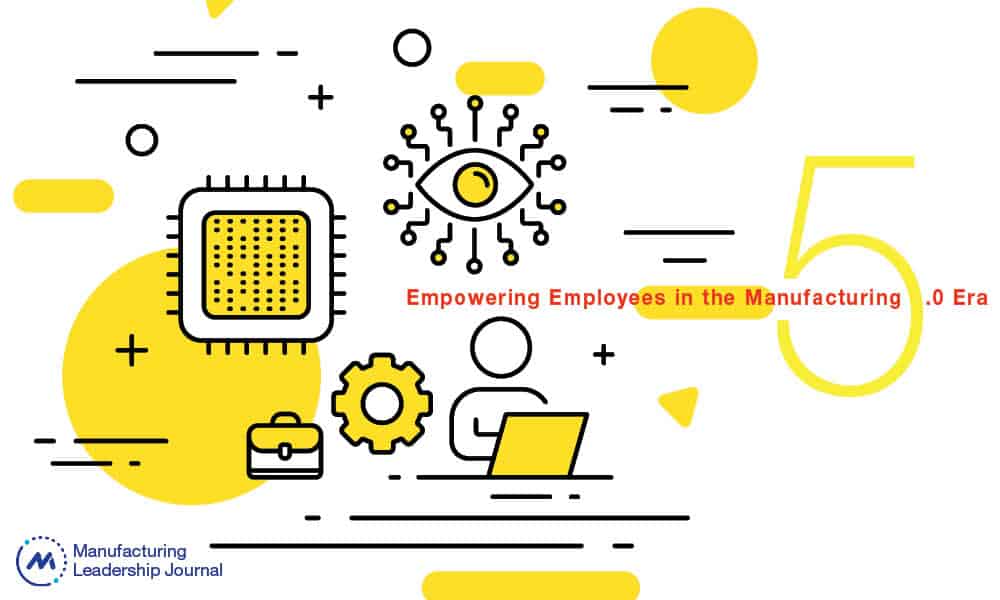
Transformational success depends on developing effective workforce strategies to prepare employees for a world of closer human/machine collaboration.

TAKEAWAYS:
● The constant flow of data from converged IT and OT systems helps employees identify potential bottlenecks and optimize operational efficiency.
● As the demand for skilled manufacturing workers increases, companies are exploring alternatives to traditional education and apprenticeships, such as on-the-job training for high school students.
● To appeal to Millennials and Gen Z, manufacturers must effectively communicate their mission and culture, emphasizing their products’ societal benefits, commitment to sustainability, and social responsibility.
The manufacturing landscape is undergoing a massive transformation driven by global changes, differences in work ethic, and rapid technological advancements. Gartner research shows that 80% of CEOs are increasing digital technology investments to counter current economic pressures, including inflation, scarce talent, and supply constraints. As a result, companies must focus on leadership, organization, culture, and people to thrive in this new era, ensuring a collaborative and innovative workforce.
Understanding the essential aspects of the upcoming era of Manufacturing 5.0, the importance of involving employees in change management, adapting to evolving workforce needs, and fostering a culture that attracts the younger generation, are now critical for manufacturers.
Manufacturing 5.0
Manufacturing 5.0 focuses on reintroducing the “human touch” to modern manufacturing processes and systems. While Manufacturing 4.0 heavily relies on digitization, connectivity, and automation technologies often replacing human tasks, Manufacturing 5.0 recognizes the importance of human skills, creativity, and decision-making in the digital transformation process. It emphasizes the collaboration between humans and machines, leveraging cognitive technologies like AI and ML to augment human capabilities rather than replace them. The goal is to create more meaningful and satisfying work experiences while harnessing the benefits of these advanced technologies to create a more flexible, adaptive, and sustainable manufacturing environment. Overall, Manufacturing 5.0 represents a paradigm shift in the manufacturing industry by emphasizing the symbiotic relationship between humans and machines, leveraging advanced cognitive technologies in new ways, and focusing on agility, sustainability, and data-driven decision-making.
The Changing Role of Employees
The need for proficient manufacturing shop floor employees has surged, prompting companies to investigate alternatives to conventional education and apprenticeships. One such alternative is on-the-job training. The effectiveness of this approach in countries like Germany has inspired other nations to contemplate implementing similar strategies. On-the-job training provides hands-on experience and skills, allowing employees to adapt quickly to the ever-changing requirements of the manufacturing industry.
Shop floor employees today need to comprehend and utilize the analysis of the growing volumes of shop floor information, in conjunction with input from advanced information technology systems that drive demand, to make crucial and timely decisions. They must understand the business more deeply than merely executing a manual task. Improved, straightforward, and seamlessly integrated information facilitates real-time data, analytics, and insights, empowering shop floor employees to make more data-driven decisions, optimize operations, and reduce downtime.
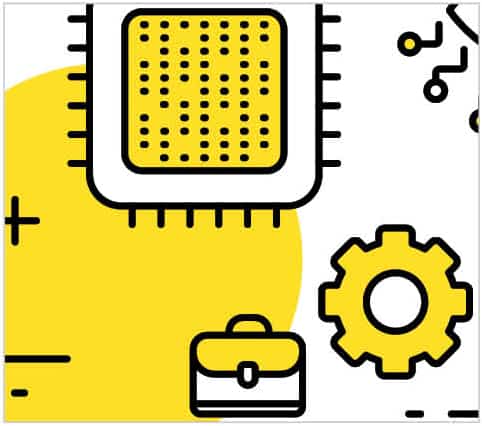
“The importance of involving employees in change management, adapting to evolving workforce needs, and fostering a culture that attracts the younger generation, are now critical for manufacturers.”
There are a number of key factors to address in this digitally enabled employee transition.
Demographic Shifts: The aging population and the retirement of experienced workers in many countries have exasperated the skills gap within the manufacturing sector. This change has intensified the demand for skilled labor, driving companies to devise new methods to train and educate their shop floor workforce. A 2020 report by the World Economic Forum predicted that 50% of employees worldwide will need reskilling by 2025, emphasizing the significance of inventive and flexible training models to keep pace with the rapid transformations in the manufacturing sector.
COVID-19 Influence: The pandemic disrupted traditional educational institutions, hastening the adoption of online and remote learning. This led to a re-examination of formal education and training models as the manufacturing sector seeks pioneering approaches to equip workers with the skills needed to face industry challenges.
Economic Hurdles: Global economic difficulties have also resulted in an increased emphasis on efficient and effective workforce development strategies. Companies are searching for cost-effective methods to train and upskill their shop floor employees, making on-the-job training an appealing option.
Bridging the IT/OT Gap: The expectations and skills of manufacturing employees are rapidly evolving as the world transitions to Manufacturing 5.0 and to the world of Open AI. Substantial modifications in plant floor Operational Technology (OT) are necessary to enhance productivity. Integrating the shop floor with Information Technology’s (IT) back office has become critical in informing decision-making processes. This convergence is the bedrock of adopting various advanced technologies, including Artificial Intelligence (AI), automation, sensors, and computer vision, to improve worker safety and overall transformation and innovation. As the world of manufacturing undergoes this transformation, organizations must actively involve their employees to upskill rather than cross-skill to bridge this gap. Coupling technical skills with soft skills is now required to achieve transformation success.
What has changed?
Well, everything. While on one end of the spectrum, we have the zenith of technologies waiting to be embraced; while the other end is still struggling with legacy systems and companies blindly investing in technologies with little to no ROI. While there is a massive shift to develop hyper-automated factories, many companies still need a structured plan to drive this transition.
Not only that, but the challenge today is also to prepare, and have a plan, to replace the aging workforce. Next, companies need to understand and identify what percentage of its workforce are replaceable with robots or collaboration bots and which human repetitive tasks can be replaced.
Fifty three percent of respondents to a recent TalentNeuron survey for example, said that the inability to identify needed skills was the No. 1 impediment to workforce transformation. Thirty-one percent reported that they also need help to identify those market-leading skills.
Fuelling Workforce Transformation
However, as robotics, automation, and AI continue to advance, they will not eliminate the need for labor on the shop floor. Instead, they will transform the kind of workforce required. According to World Economic Forum’s “Future of Jobs Report 2020” that gathers the insights from the largest companies worldwide on the changing nature of work; by 2025, humans and machines would share equal task loads, with 85 million jobs worldwide being displaced by automation and AI, while 97 million new roles will be created. This means an increase in labor as more new jobs emerge.
The rapid development of robotics, automation, and artificial intelligence (AI) has led to more sophisticated machines that can perform tasks previously handled by humans. This caused a shift in the labor market, where new skills and expertise are required to keep up with these changes. While AI could increase labor productivity there is a need to upskill and reskill shop floor workers to adapt to the changing labor market.
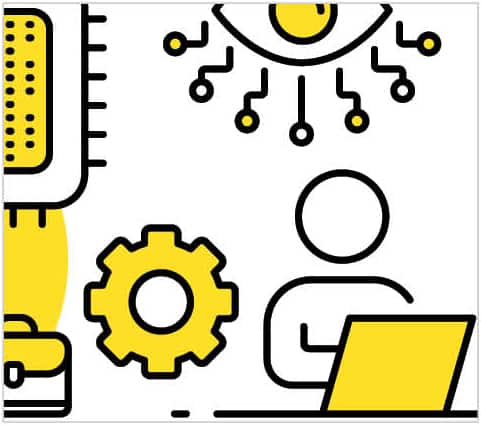
“Improved and seamlessly integrated information facilitates real-time data, analytics, and insights, empowering shop floor employees to make more data-driven decisions.”
As machines become more capable of performing tasks, there is also an increasing demand for shop floor workers who can manage, develop, and maintain these systems. This transformation in the labor market signifies an evolution in the skill set needed for employees. Shop floor employees now require specialized training in robotics, automation, and AI to develop the skills necessary to work with these technologies. Much of the activity will be provided by machine manufacturers, while additional training can be accessed online.
Embracing Change and Sustainability
The manufacturing industry must adapt to the changing workforce, technology, and global landscape challenges. As a result, companies must foster a culture of continuous learning, innovation, and adaptability, prioritizing trust and employee well-being.
As the workforce becomes more diverse, companies must also ensure that their culture and policies are inclusive and provide equal opportunities for all employees. By embracing diversity and promoting inclusion, companies can tap into their employees’ unique skills, perspectives, and experiences, leading to improved innovation and performance.
As manufacturing undergoes a technological revolution characterized by adopting Manufacturing 5.0, automation, and digitalization, companies must invest in upskilling and reskilling their workforce to adapt to new technologies and processes to stay competitive. This requires fostering a continuous learning and innovation culture, where employees are encouraged to keep up-to-date with the latest industry trends and developments.
As the global market becomes increasingly interconnected, manufacturers face increasing competition, economic fluctuations, and regulatory pressures. Companies must develop strategies to navigate these challenges while maintaining sustainable practices considering environmental, social, and economic factors.
Companies should also prioritize confidence and employee well-being by providing supportive work environments, encouraging open communication, and offering resources for mental and physical health. A strong focus on employee well-being can improve productivity, retention, and company performance.
Finally, as shop floor employees reduce manual tasks and become machine managers using computers, operational technology, and information technology, their ability to work remotely will improve. That being said, envisaging a hybrid work model for shop floor employees can be challenging because of the nature of the work and the need for continuous production. Supervisors are already using phones to keep track of machine operations over multiple shifts, especially in process manufacturing and, more often, in discrete Manufacturing, where machine productivity requires 24/7 operation. Implementing periodic shifts for shop floor employees can help the manufacturing industry transition to a hybrid work culture.
Change Management, Done right.
As manufacturers begin to navigate these fundamental operational and workforce changes, there some basic guidelines that may help leaders adopt more enlightened workforce cultures.
Open Communication: The successful implementation of advanced technologies largely depends on the involvement of employees in change management. Therefore, organizations must focus on a culture of open communication. Shop floor employees are often the best source of information on productivity and quality improvements. Companies should encourage employees to share their thoughts, concerns, and ideas. This establishes a sense of ownership and commitment among the workforce. Based on research conducted by McKinsey, the likelihood of a successful transformation increases 5.8 times when CEOs convey a persuasive and overarching narrative of change. Furthermore, the chance of success rises 6.3 times when top executives disseminate consistent and unified messages about the change initiative.
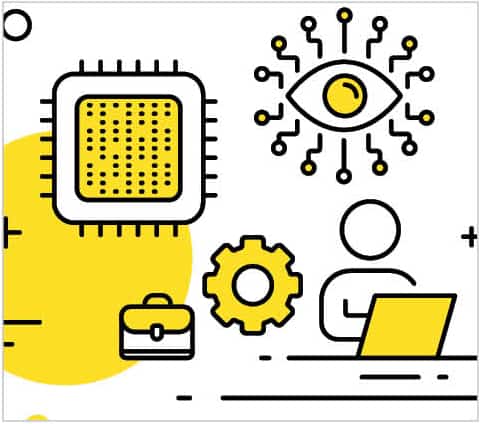
“Younger employees are often passionate about environmental sustainability and may be more inclined to work for companies committed to reducing their ecological footprint.”
Reward Cross-Skilling: Organizations must invest in training and reward skill development programs to equip their workforce with the knowledge and skills required to adapt to higher analytical skills driven by new technologies. This enhances employee capabilities and ensures a smooth transition to the new systems.
Leadership through Mentorship: Companies should also provide their employees with the necessary support and resources during the transition. This includes mentorship, guidance, and the availability of resources to address any challenges or issues that may arise.
Internal Communication: Organizations must emphasize adapting to new technologies and their potential benefits as part of their internal communications strategies. This can be achieved through awareness campaigns, workshops, and presentations highlighting the value these technologies bring to the organization regarding efficiency, productivity, and safety.
A study conducted by the Boston Consulting Group found that organizations that successfully implemented change initiatives like these were 3.5 times more likely to effectively communicate the benefits of change to their employees, resulting in increased employee buy-in and support for the changes.
Attracting a Younger Workforce
The younger generation, often called millennials and Gen Z, tends to prioritize working for companies and non-profits that have a clear, positive impact on society. To appeal to this demographic, manufacturers must communicate their mission and culture effectively, emphasizing how their products contribute to the greater good.
A strong mission statement that reflects the company’s core values and goals can resonate with younger employees, who are often driven by a sense of purpose in their work. This generation seeks to make a difference, and by aligning the company’s mission with societal benefits, manufacturers can create a more attractive workplace for young professionals.
A company’s culture is the set of shared values, beliefs, and practices that shape the work environment. A positive, inclusive, and empowering culture can be a significant draw for younger employees who prioritize work-life balance and personal development. In addition, manufacturers can improve employee satisfaction and engagement by promoting a healthy work culture.

“Companies should encourage employees to share their thoughts, concerns, and ideas. This establishes a sense of ownership and commitment among the workforce.”
Younger employees are often passionate about environmental sustainability and may be more inclined to work for companies committed to reducing their ecological footprint. Manufacturers can appeal to these values by adopting eco-friendly practices, investing in green technologies, and promoting transparency around their sustainability initiatives.
The younger workforce is also attracted to companies that take an active role in addressing social issues and contributing to the communities in which they operate. Manufacturers can showcase their commitment to social responsibility by engaging in philanthropy, volunteer programs, and community partnerships. These initiatives help attract and retain young talent and enhance the company’s reputation and brand image.
The Way Ahead
The transition to Manufacturing 5.0 has brought about significant changes in the manufacturing landscape, requiring companies to adapt to evolving technologies, workforce demographics, and global challenges. To thrive in this new era, manufacturers must involve their shop floor employees in change management, invest in training and skill development programs, and foster an open, collaborative, and innovative culture. In addition, manufacturers can attract and retain the younger workforce, who drive innovation and success in the industry by embracing diversity, prioritizing employee well-being, and adopting sustainable practices. M
About the authors:

Neha Aggarwal is Assistant Vice President and Head, Vertical Strategy Group at Birlasoft.

Paul Menig is a Senior Business Consultant at Birlasoft.
What Got You Here, Won’t Get You There
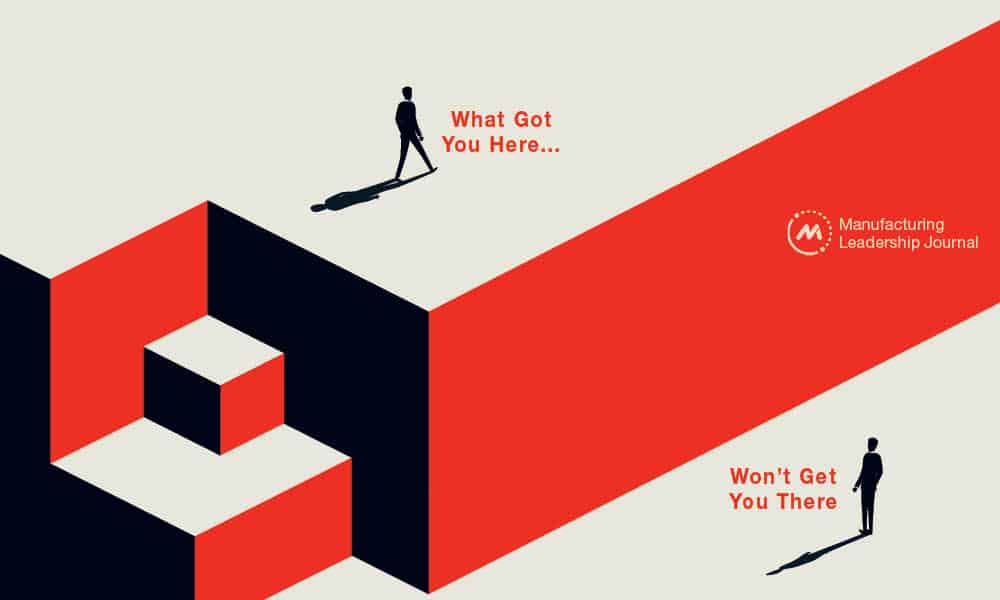
To move into the digital future, manufacturing leaders must lead with disruption and innovation.

TAKEAWAYS:
● Transformation starts with leadership.
● Employee-wide upskilling development is needed.
● How to instill a learning culture.
The manufacturing industry continuously faces new challenges in an ever-changing landscape. Leaders must contend with increasing demands to adopt sustainable practices, the need for greater data security, rising customer expectations, and difficulties around recruiting and retaining talent as skilled workers approach retirement.
This complex landscape requires disruptive and adaptable manufacturing leaders ready to navigate uncertainty and introduce new ways of working designed to fit shifting priorities.
To do this, leaders will need to look inward to identify the behaviors that will support and empower workers, upskill current employees, and cultivate a culture of constant learning.
Transformation Starts With Leadership
The new transformative, disruptive manufacturing leader will need to pivot away from “business as usual” to a digital-first “change as usual” mindset. They must understand and embrace data, be able to role model digital behaviors, leverage the strengths and behaviors of the team and individuals to retain competitive advantage, and bridge the gap between the now and ever-changing digital future.
Contrary to popular belief, leadership is not a stand-alone, isolated activity. The new leader must be able to ideate, innovate, and create future solutions while leading, empowering, and engaging teams undergoing transformation. This leader should encourage people to think and operate outside the box. In an industry that is heavily product driven, this new paradigm will need to be applied with caution given the reduced margin of error within this sector.

“The new leader must be able to ideate, innovate, and create future solutions while leading, empowering, and engaging teams”
PA Consulting recently surveyed over 300 business leaders across the U.S., U.K., and Europe to explore the behaviors driving the new way to lead. The finding revealed that over the next five years, the following behaviors will be critical to success:
- Nurture human optimism by helping people create a positive mindset and approach, tapping into people’s innate capacity to adapt to new and complex situations with innovation and creativity.
- Empower teams to innovate by inspiring people to understand their customers’ desires and giving them the space and permission to imagine and deliver value-creating responses.
- Build evolving organizations by creating environments where rapid change is the norm, and where aware, inclusive, and responsive teams can make a success out of change.
- Seek inspiration in surprising places by applying new perspectives and a broader lens to both existing technologies and evolving challenges.
An overwhelming majority of surveyed leaders recognized the importance of those behaviors as essential to leadership now and in the future. Moreover, these behaviors are linked to 70% and 74% better outcomes in performance and societal outcomes, respectively.
Driving Economic Optimism Through Upskilling and Learning
To lead systematic change and deliver organizational transformation at pace, businesses must ensure that all employees are prepared and ready to face the challenges of the 21st century. Indeed, being disruptive isn’t just about thinking differently, it’s about having a stable and secure organizational foundation to take risks and adapt. To do so, leaders must prioritize building new talented teams, upskilling and transforming the learning capability.
The World Economic Forum’s Future of Jobs Report states that due to the growing uptake of technology and automation, half of all employees will need reskilling by 2025. This remains particularly relevant within manufacturing where operationally intensive companies begin to enter a new era of automation reliance. In Europe and the U.S., demand for physical and manual labor for repeatable and predictable tasks within the sector is predicted to decline by nearly 30% over the next decade. In contrast, the requirement for digital skills (coding analytics for example) is predicted to almost double. Finally, demand for high-level social and emotional skills will continue to increase as global partnerships and supply chain complexity expand. Such significant workplace trends present real challenges, and opportunities, to manufacturing firms.
Create a long-term vision for growth
In this context, leaders can no longer rely on a reactive and short-term people strategy but must look to develop a long-term vision for growth, which recognizes the importance of an adaptable and cognitively mobile workforce. The economic incentive remains paramount and clear: retention and training are, and will continue to be, a more sustainable and effective employee policy than hiring new employees. Moreover, shifts in societal and workplace attitudes will only strengthen this approach and the expectation that employers must do more to retain their current workforce where possible. In light of this clear momentum shift, what can leaders do to guide this skills transition and drive progress?

“Employees should be encouraged to embark on their own upskilling journey through conversations and development plans”
Companies must ensure that any upskilling forms part of a larger digital strategy. Acquiring top talent remains a common barrier to achieving digital strategies, and success in either requires a combined approach that sees upskilling as a critical cog in the wider digital wheelhouse. Here, leaders must engage with serious discussions around workforce planning and resource allocation to design effective upskilling capability.
Reward and incentivize training
Upskilling and reskilling must be widely promoted and resourced at all levels to ensure enterprise-wide adoption. Leaders must consistently communicate its value, actively endorse and support opportunities, and identify risks of reduced adoption. Where possible, employers should look to reward and incentivize upskilling activity (both compensatory and non-compensatory). At the very minimum, employees should be encouraged to embark on their own upskilling journey through regular career development conversations and bespoke development plans. Flexible learning and additional staff development products such as microlearning and flexible time off should also be reviewed in order to see a noticeable shift in this area.
Leaders should work closely with learning and development (L&D) teams who have a wealth of learning resources, training skills, and valuable workforce data on required future skills and learning needs. Leaders should also discuss emerging trends, business needs and skill requirements to inform the L&D teams’ programs and middle leadership layer. A strategic response to this upskilling challenge will inform leaders and encourage staff to take up opportunities to upskill and grow. Developing an online opportunity marketplace or talent-seeking resource hub can help to meet business needs and develop individuals and teams.
Finally, upskilling provides numerous benefits to both employees and organizations. The meaning and importance of work have changed over time and research has shown that the main motivating factor is no longer money. More people are reevaluating their priorities, looking at their work-life balance and wanting their work to be meaningful, purposeful, and in harmony with their beliefs and values. When aligned with organizational beliefs, mission, and values, the power of upskilling is even stronger.
Cultivating a Life-Long Learning Culture and Digital Mindset
Manufacturing 4.0 is primarily anchored in interconnectivity which is underpinned by insights garnered from automation, machine learning (ML), big data analytics, and real-time data. Moving into a digitally enabled era means that there is an ever-greater expectation of delivering innovative products to the market at speed. This means that success ultimately lies in how well organizations are able to move their people to become truly innovative, agile, and collaborative in order to overcome increasingly complex structures and meet future customer demands.

“It is crucial for leaders to cultivate a foundational culture of life-long learning and a digital mindset”
Organizations going through such Manufacturing 4.0 digital transformations will recognize that, alongside investing in new technologies and upskilling/reskilling employees in how to use them, it is apparent that technological advances and the unexpected changes they bring are here to stay. To be unequivocally fit for the future, therefore, it is crucial for leaders to cultivate a foundational culture of life-long learning as well as a digital mindset that will inspire their teams and enable them to find creative solutions at an unprecedented pace.
Create a psychologically safe environment
Creating a life-long learning culture and a new digital mindset requires the right platforms and resources to provide more informal, on-demand, and bite-size learning opportunities that can be accessed alongside day-to-day work, and also an environment of psychological safety. Like evolving learning approaches, performance and development conversations are now also occurring both more frequently and informally, to meet the real-time nature of new or changing demands.
For manufacturing in particular, a move to greater automation can create substantial changes physically (from the shop floor to an office setting) as well as behaviorally (towards a fail-fast agile learning mindset), and this can create psychological unease. The uncertainty presented by inevitable technological and societal developments will require leaders to be proactive in offering a leadership style that is more sensitive, adaptive, and empowering so that their teams feel heard and supported through these shifts. In turn, this authentic approach to investing in employees and providing recognition of their intrinsic value will also help to retain and attract talent in these challenging times.
Transformation is now commonly viewed as being more of a journey than an end point. The long-term capability and culture of life-long learning will need authentic leadership to generate a psychologically safe environment that motivates teams to evolve, grow, and disrupt so that businesses don’t just survive but truly thrive. M
About the authors:

Nigel Lowe is a Partner and people and change expert at PA Consulting

Nini Ali-Khan is a change management expert at PA Consulting

Shanton Wilcox is a Partner and America’s Leader in Manufacturing at PA Consulting



